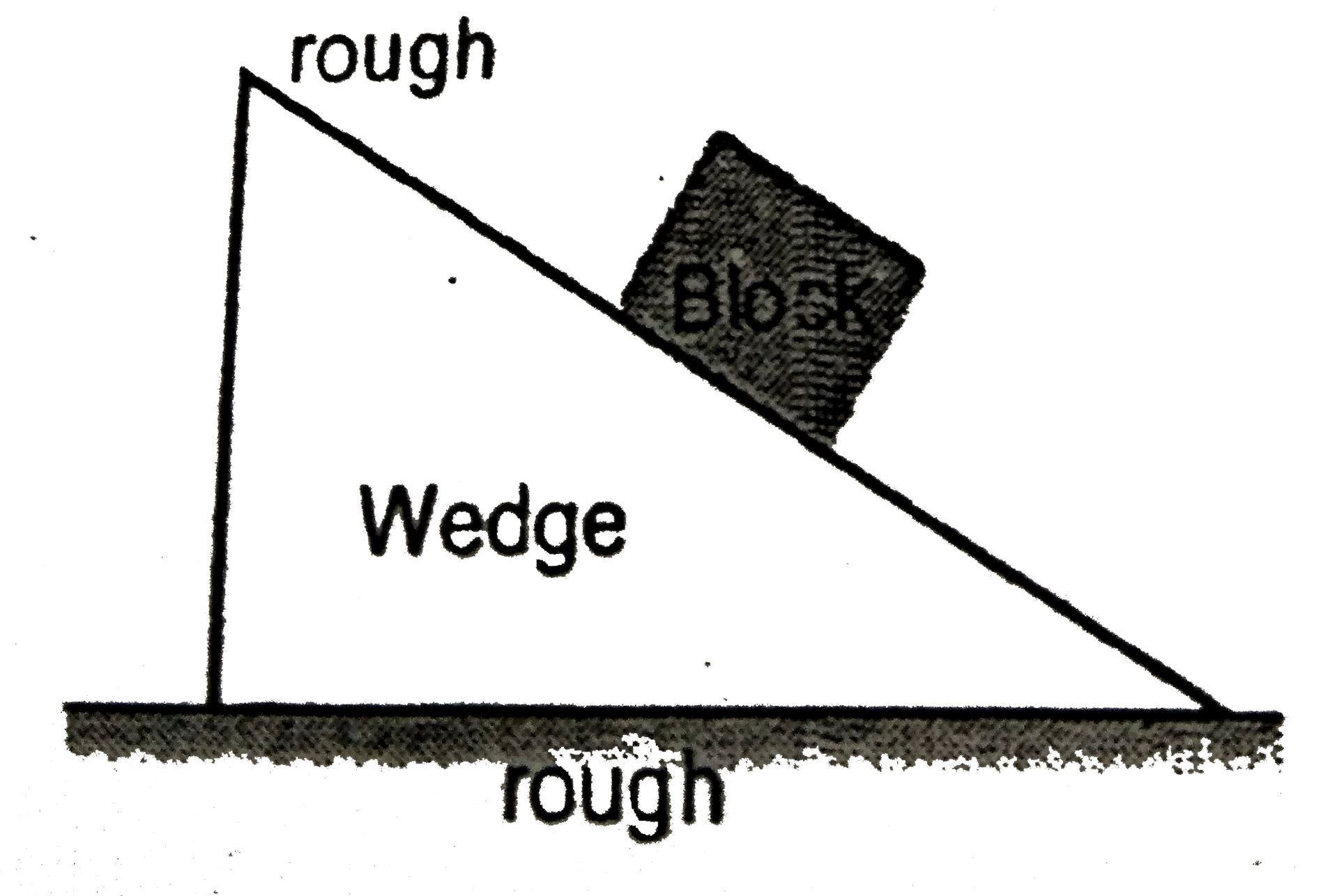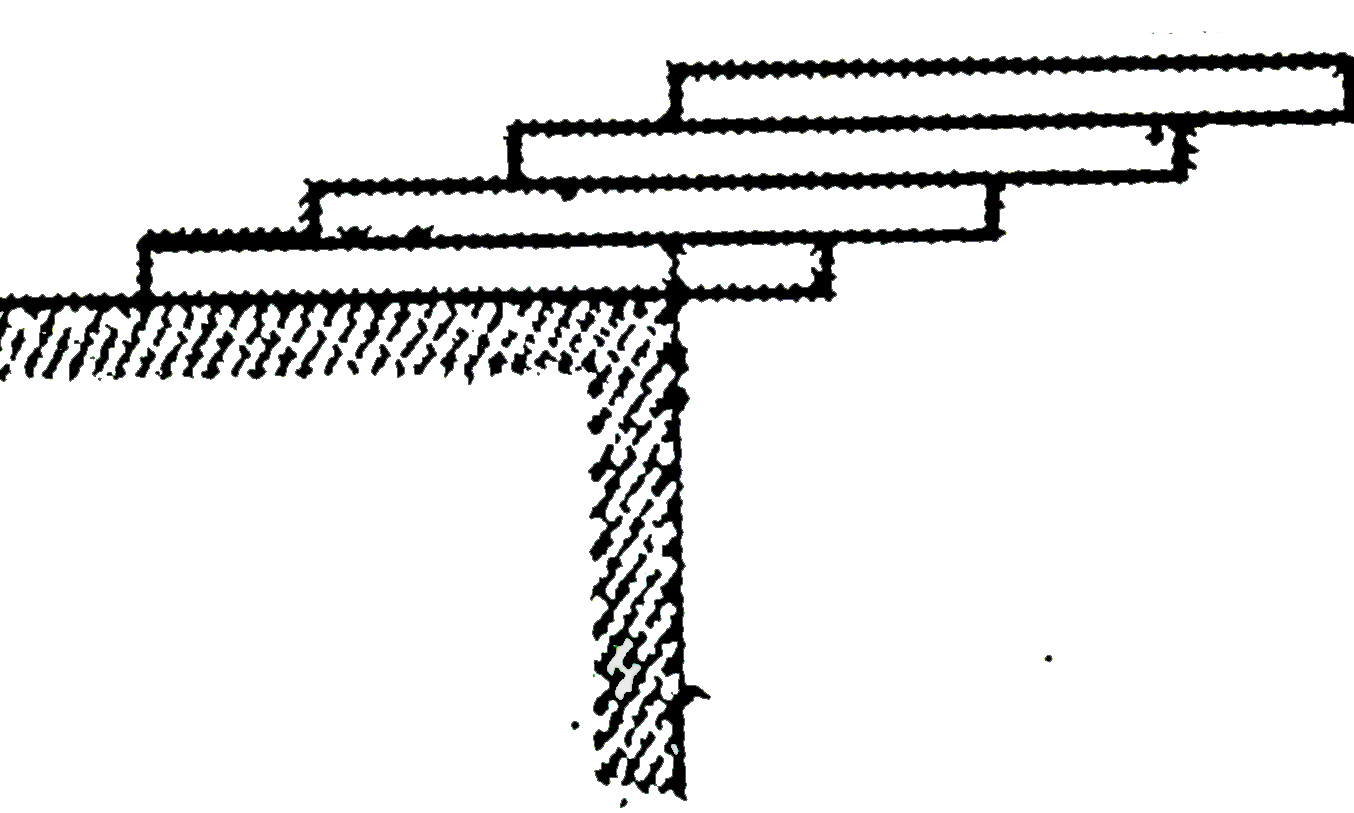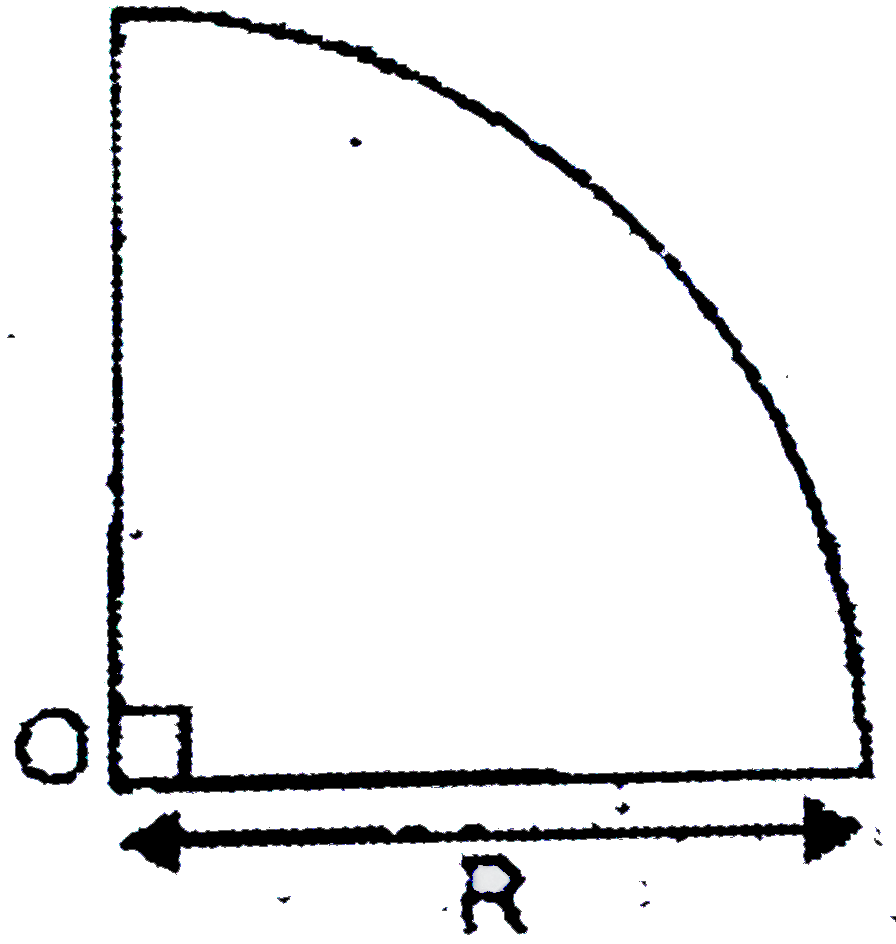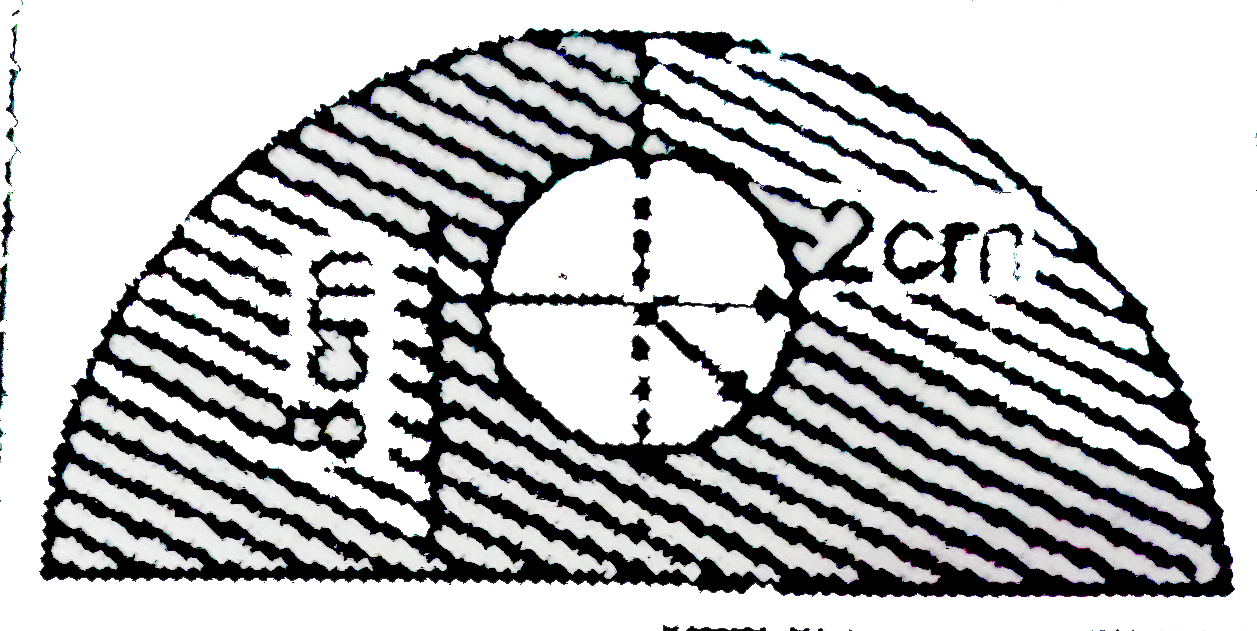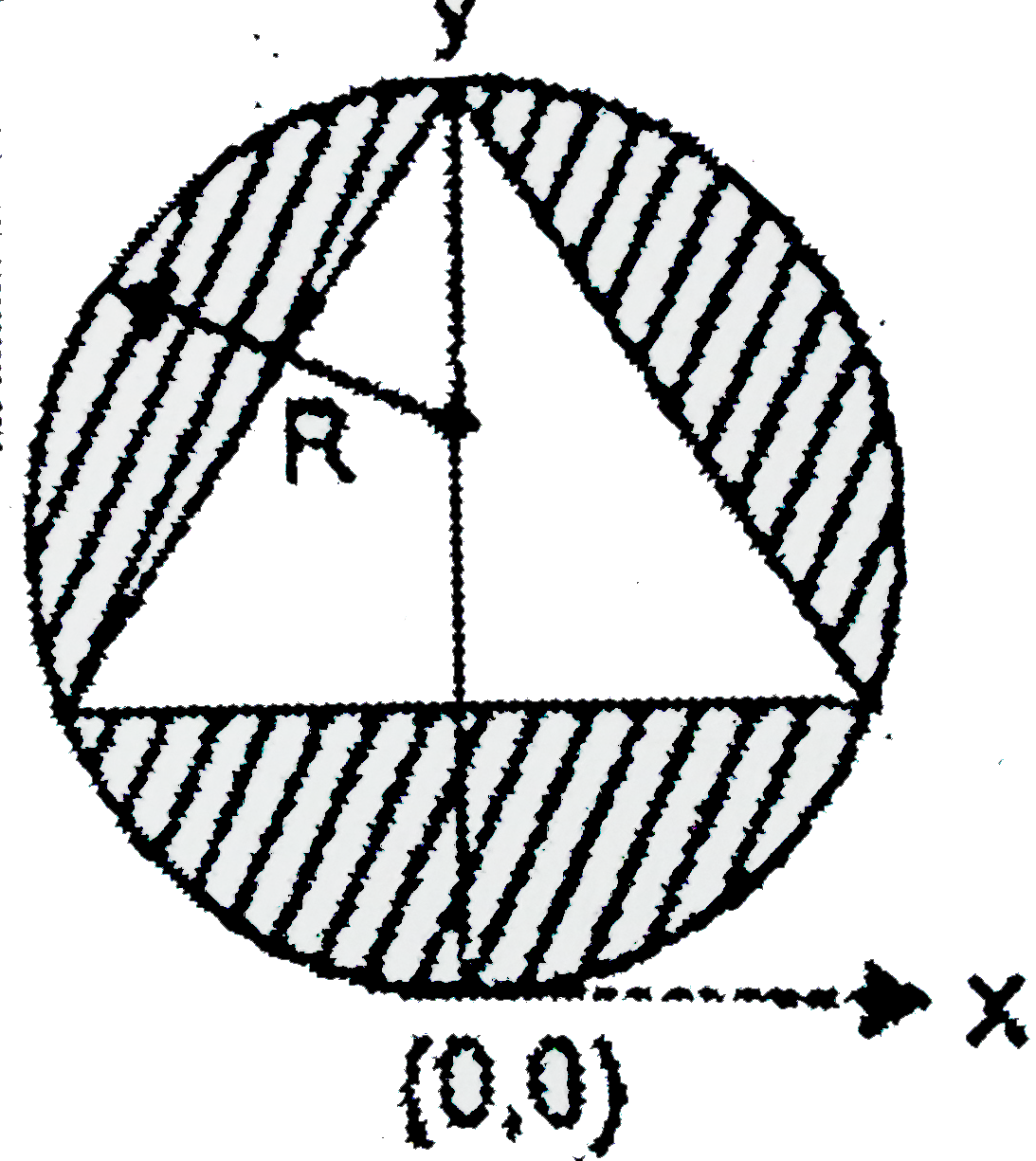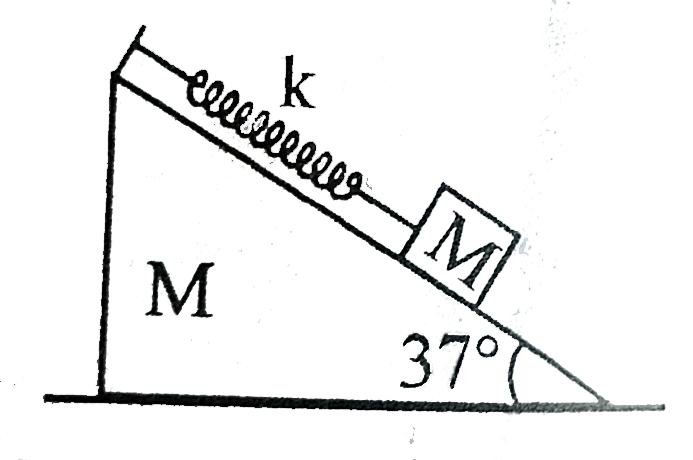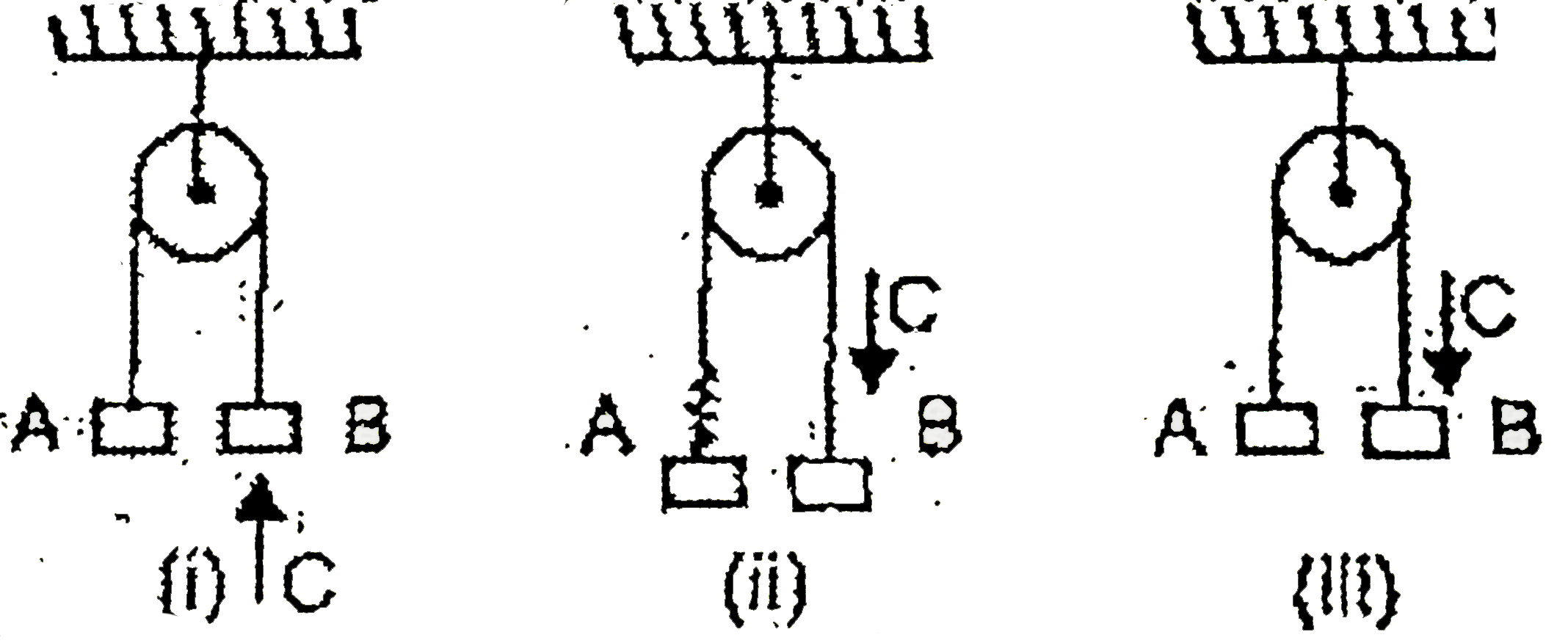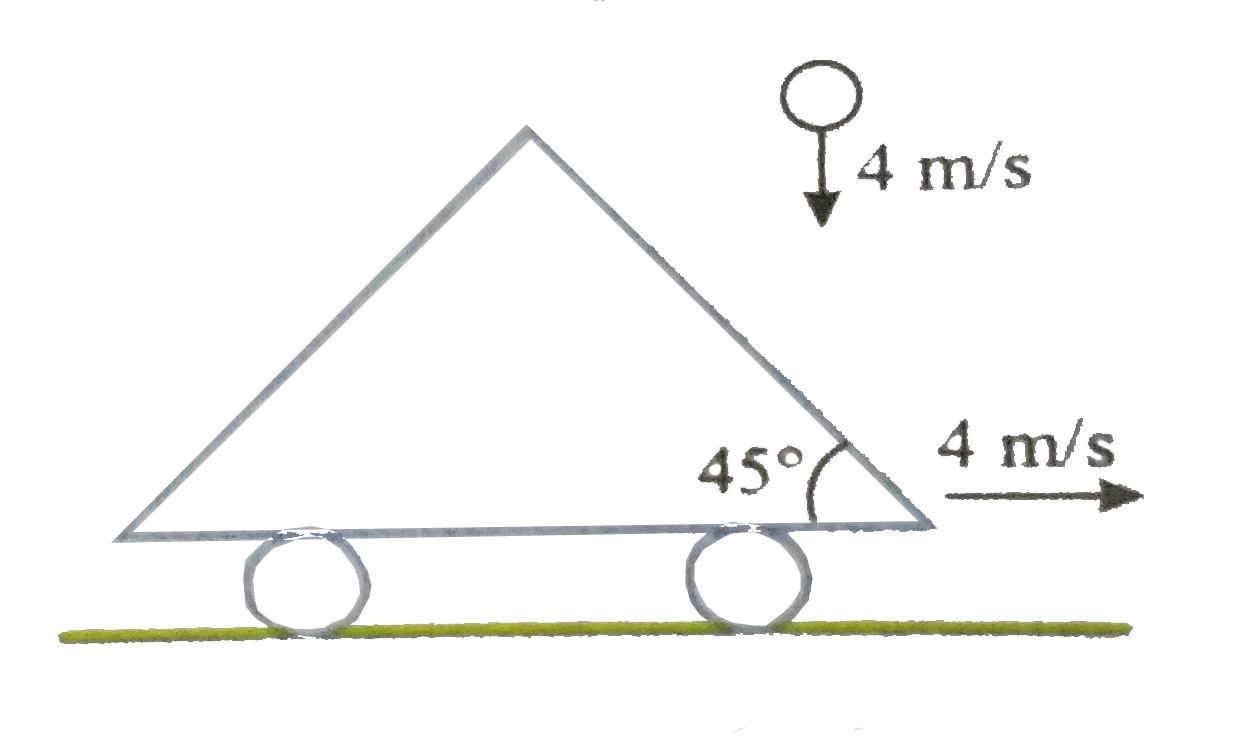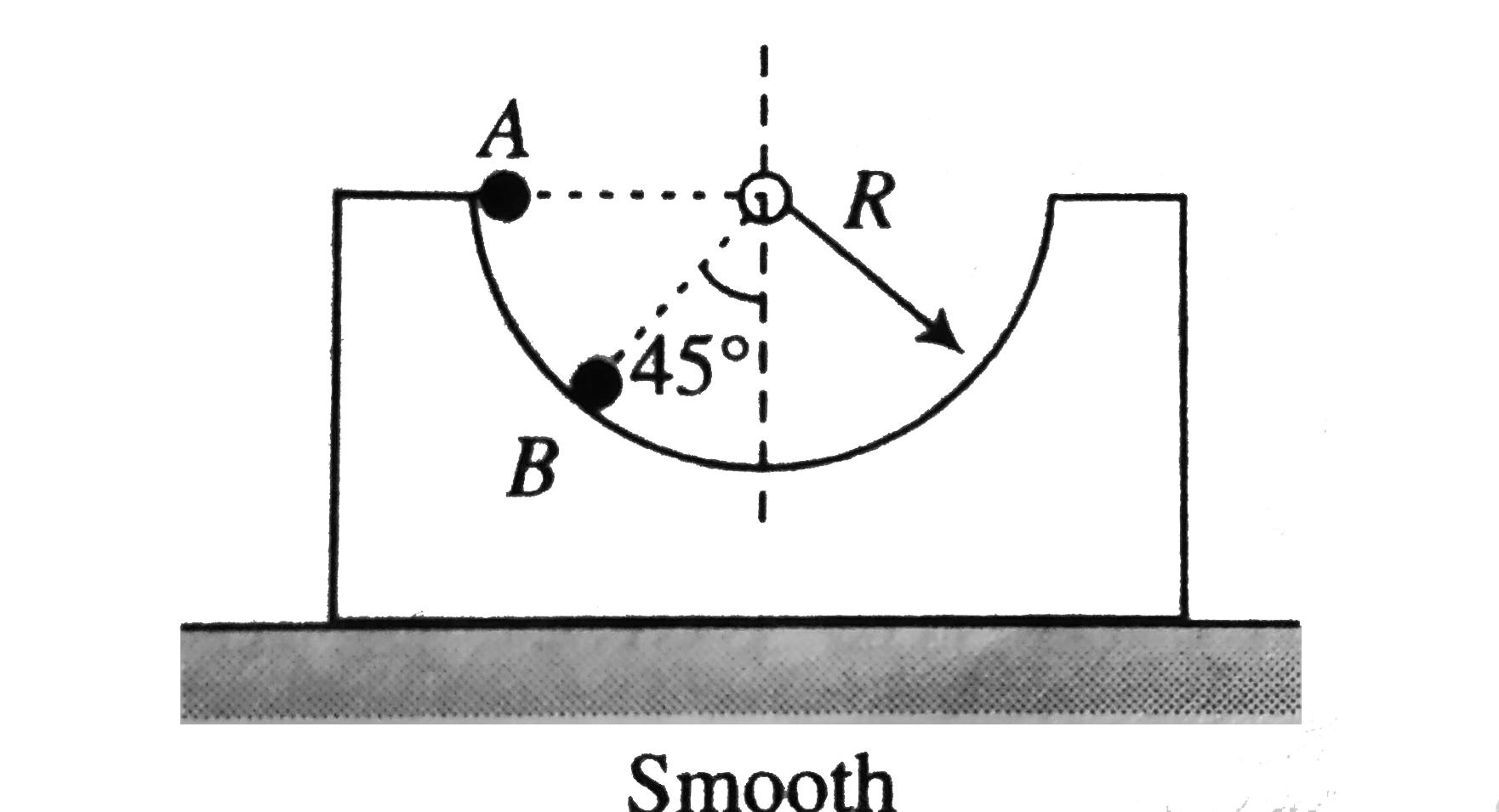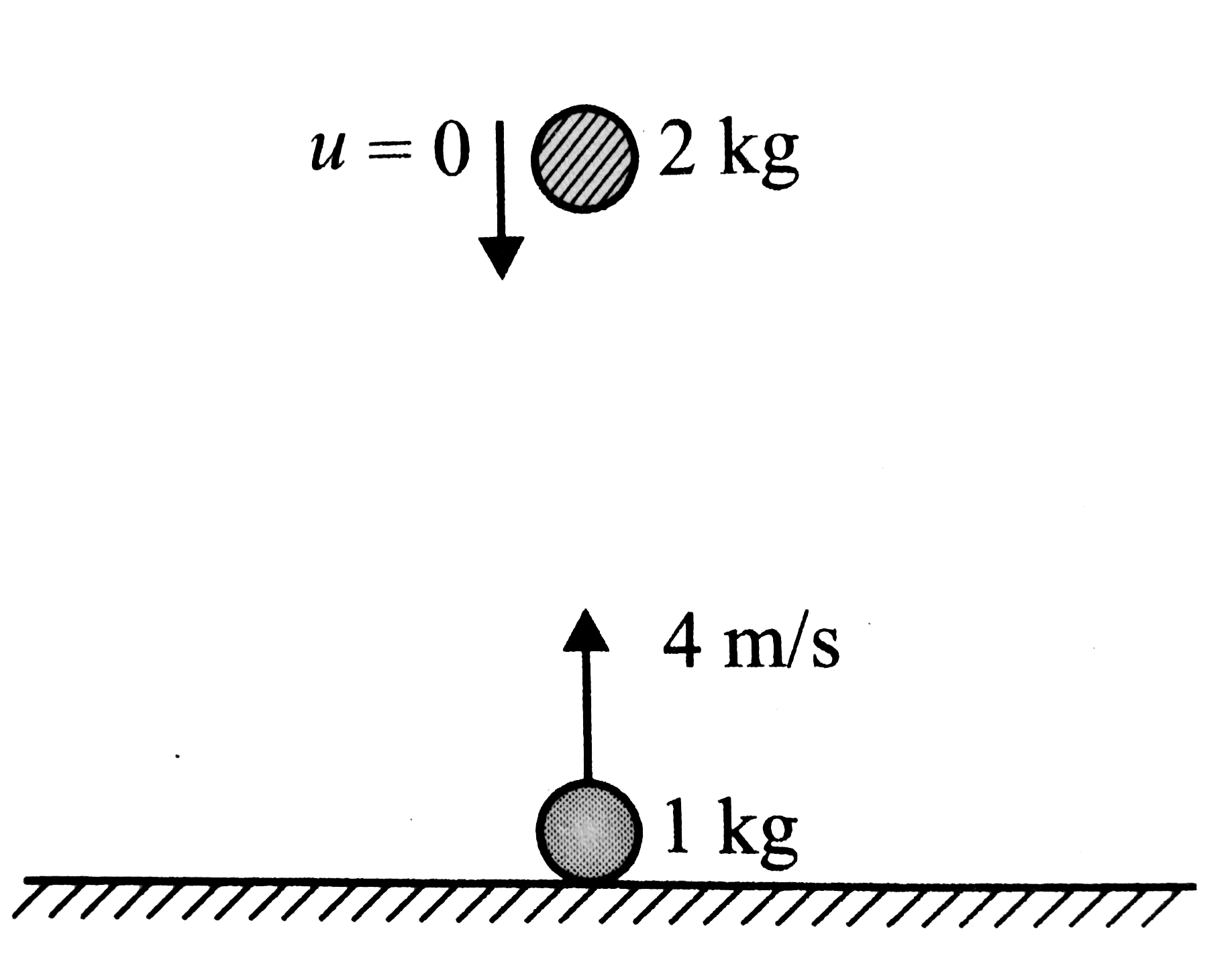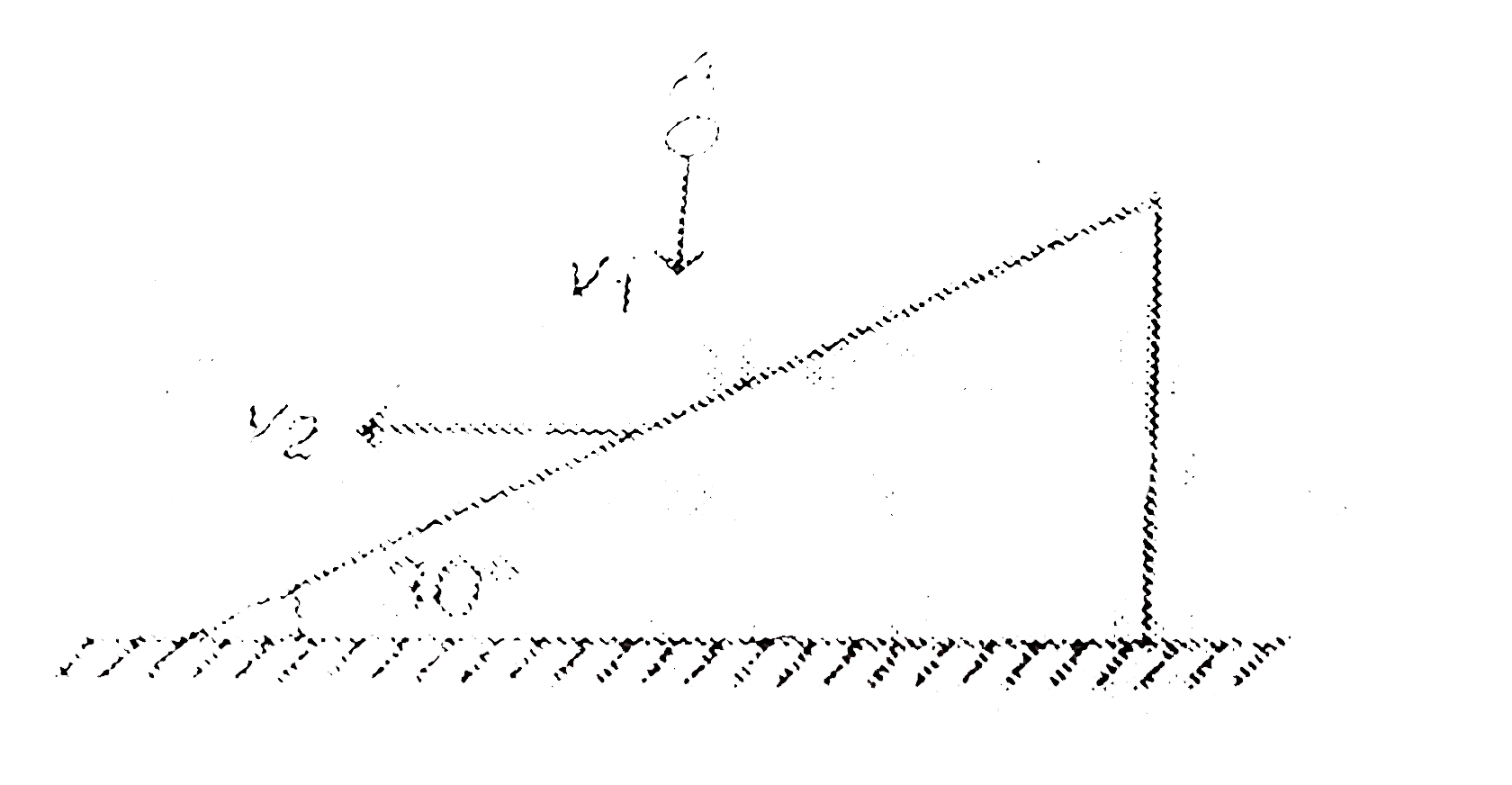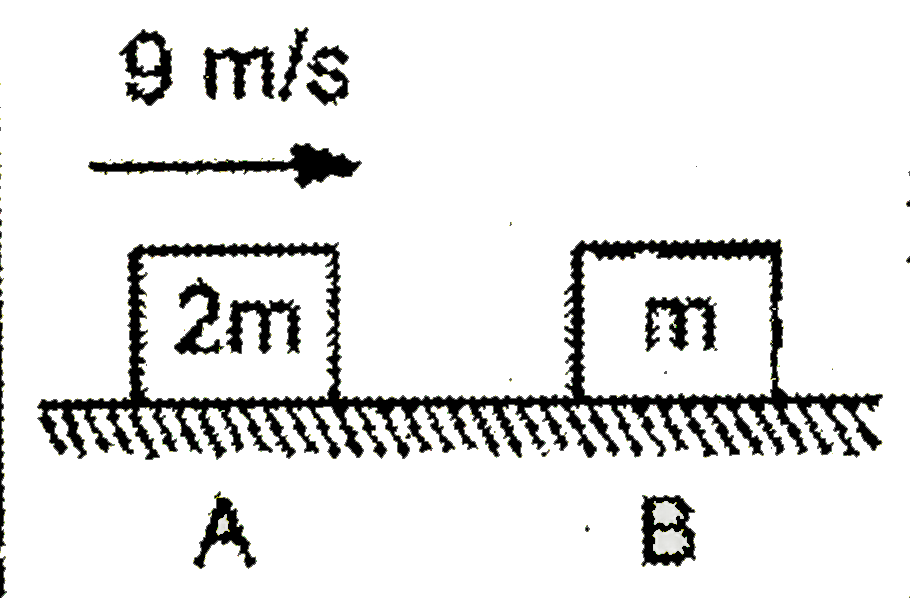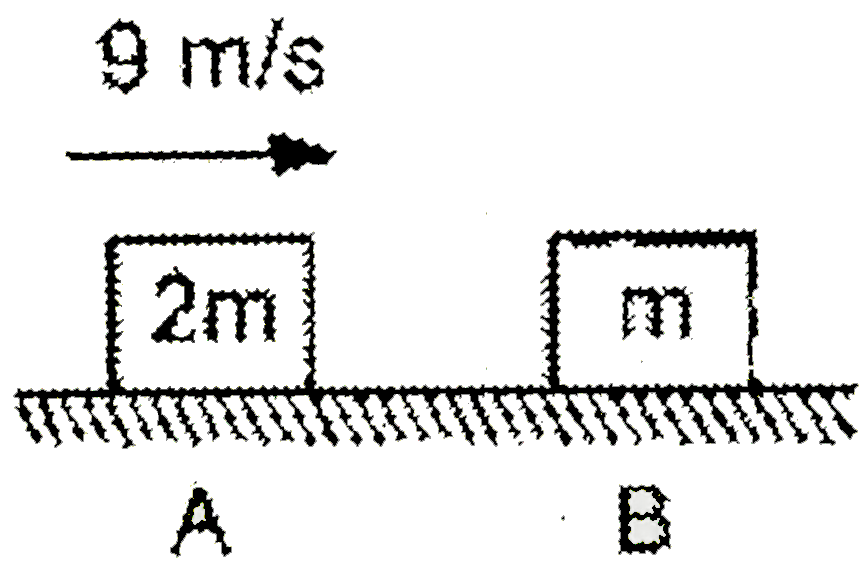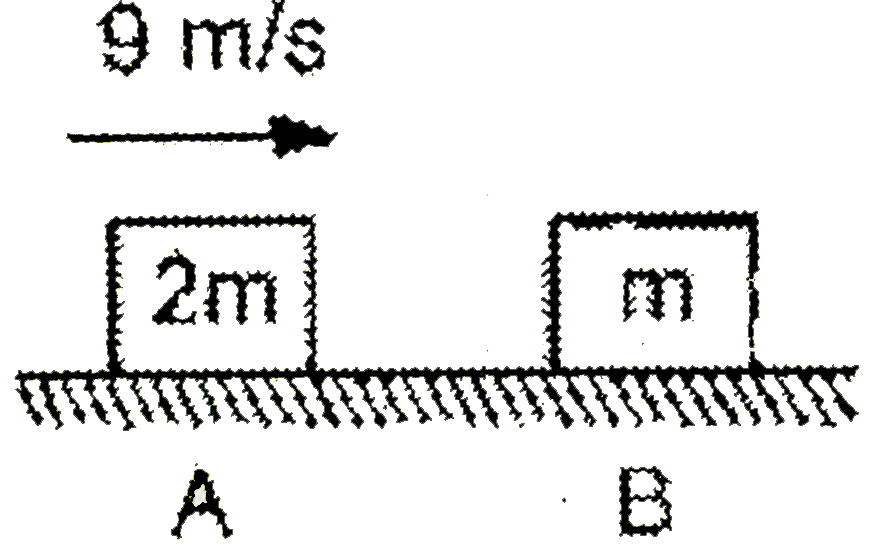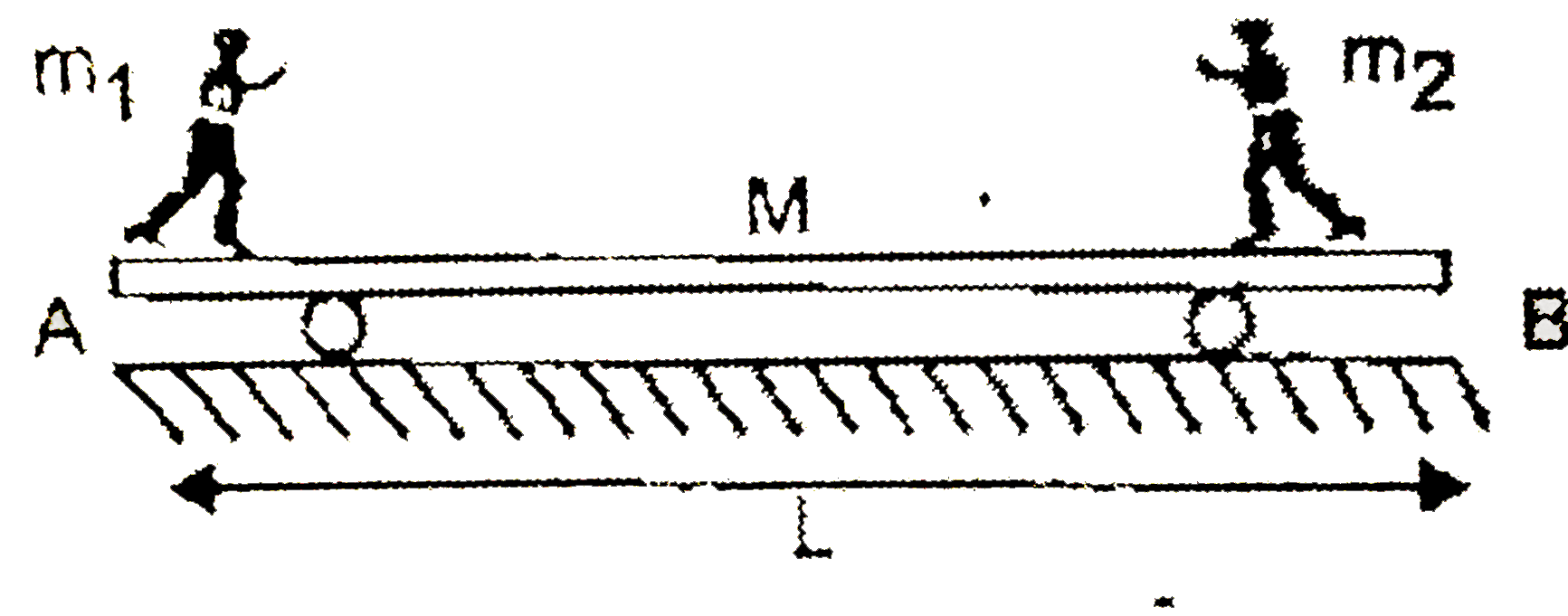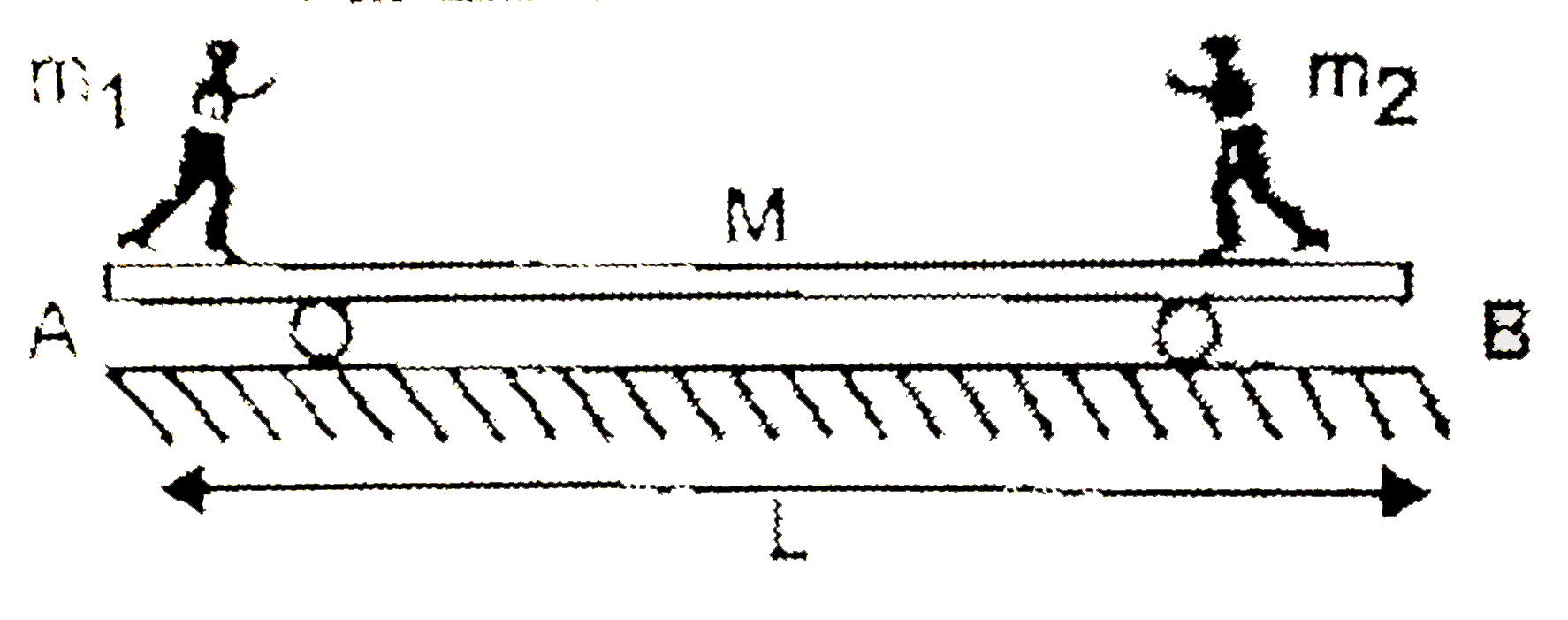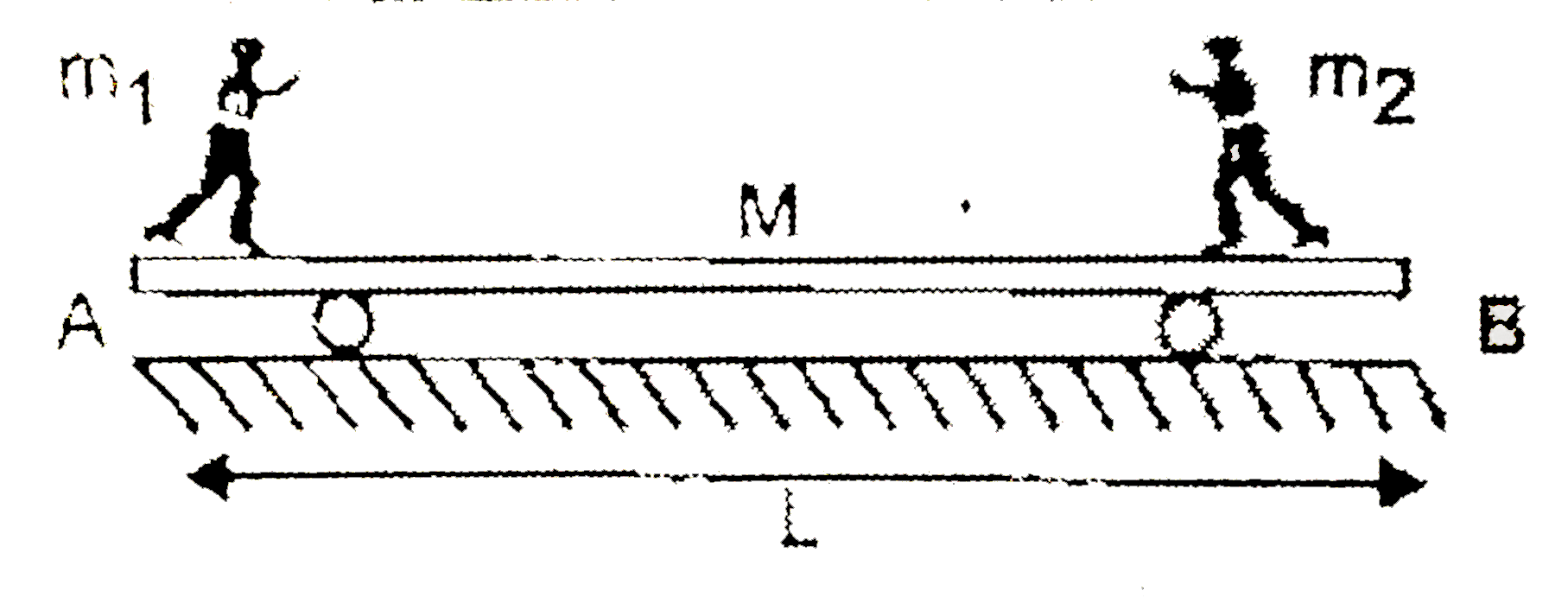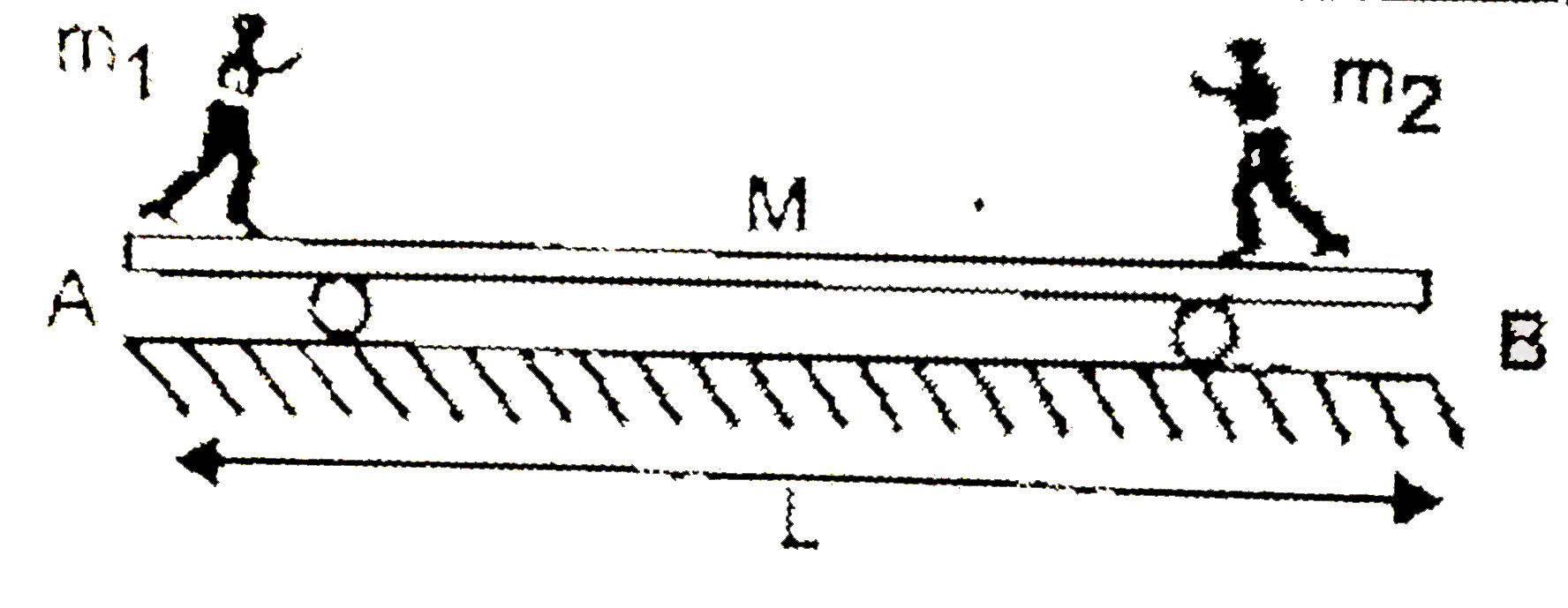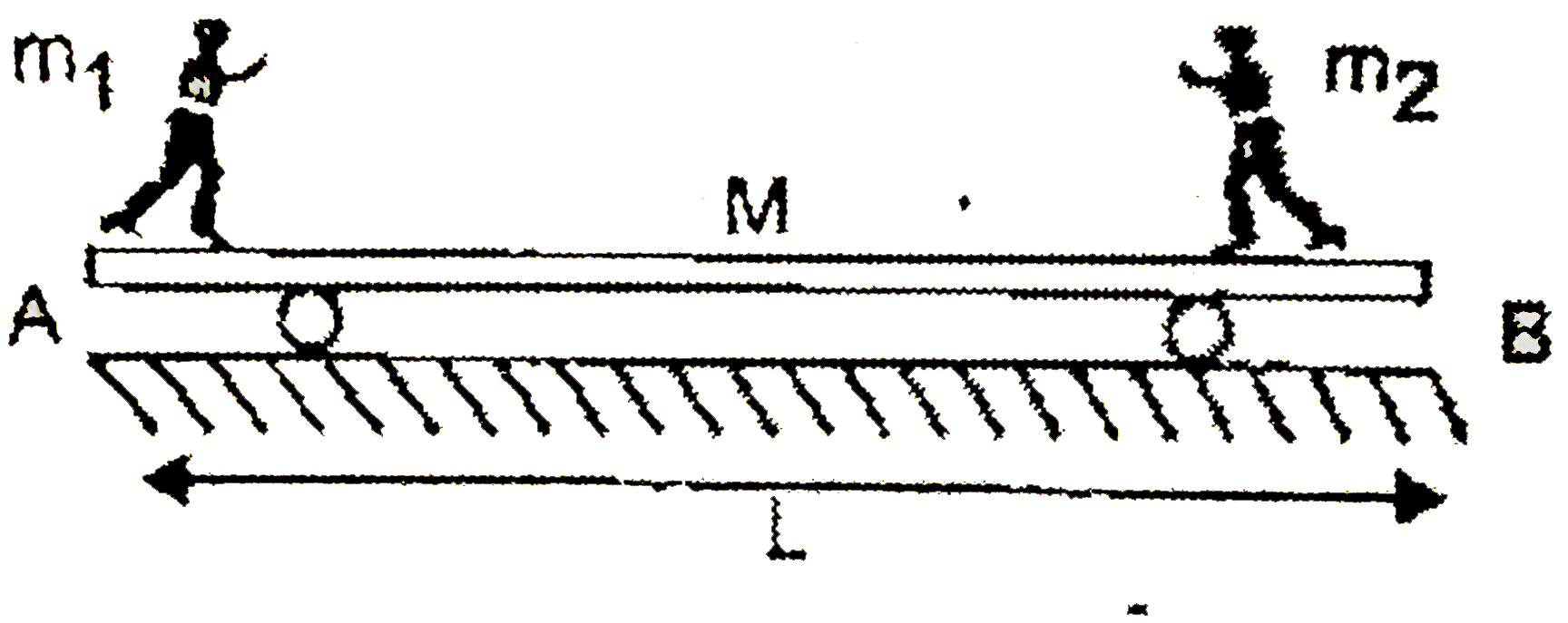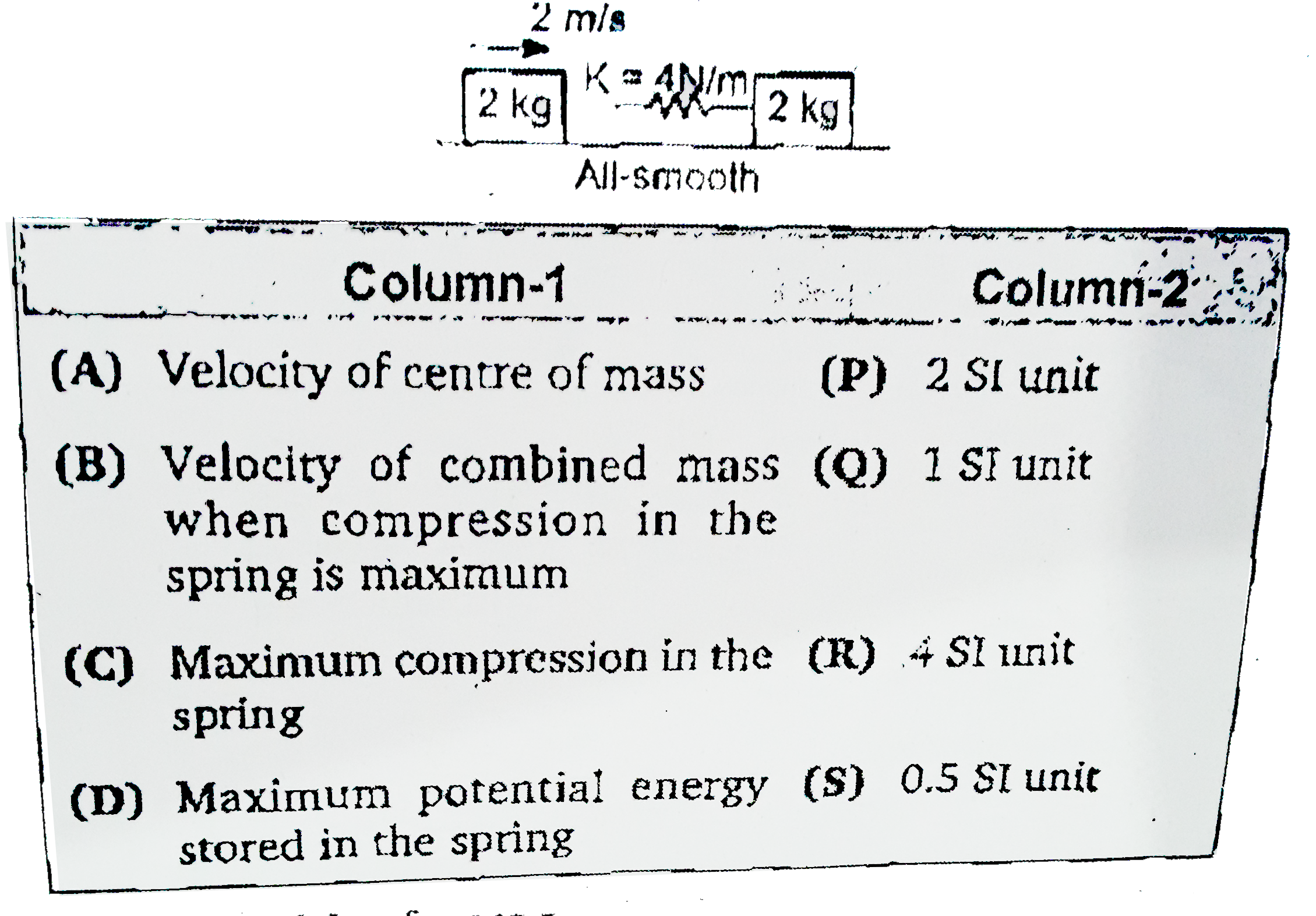P-13 from SHREE BALAJI PHYSICS (HINGLISH) IMPULSE AND MOMENTUM for Class 11
| Class 11 | PHYSICS |
| Chapter | IMPULSE AND MOMENTUM |
| SHREE BALAJI PHYSICS (HINGLISH) | P-13 |
| Medium | English |
| Academic Year | 2023-2024 |
Question 1
A set of n identical cubical blocks lies at rest parallel to each other along a line on a smooth horizontal surface. The separation between the near surfaces of any two adjacent blocks is L . The block at one end is given a speed v towards the next one at time 0 t . All collisions are completely inelastic, then View SolutionQuestion 7
In the figure shown, the two identical balls of mass M and radius R each, are placed in contact with each other on the frictionless horizontal surface. The third ball of mass M and radius R2' is coming down vertically and has a velocity =υ0 when it simultaneously hits the two balls and itself comes to rest. Then, each of the two bigger balls will move after collision with a speed equal to :
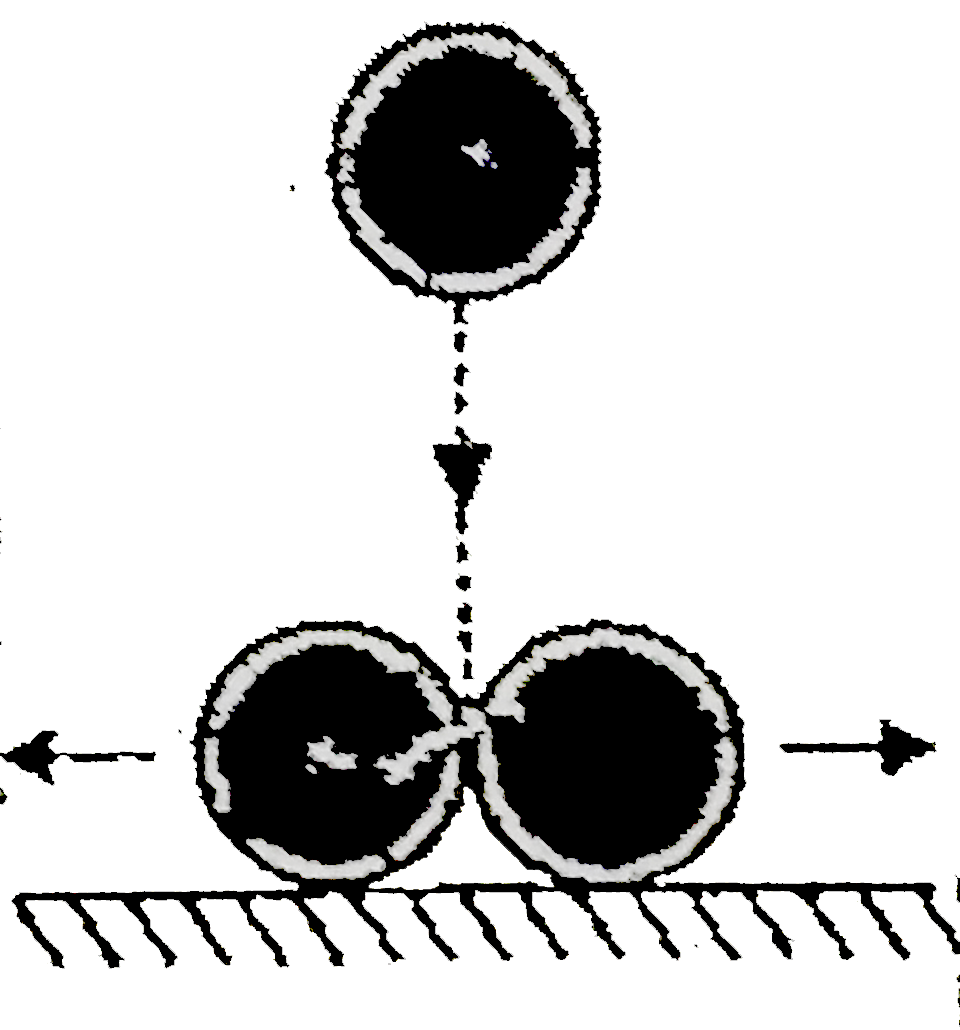 View Solution
View SolutionQuestion 12
On a horizontal smooth surface a disc is placed at rest. Another disc of same mass is coming with impact parameter equal to its own radius. First disc is of radius r. What should be the radius of comping disc so that after collision first disc moves at an angle 45∘ to the direction of motion of incoming disc ?View SolutionQuestion 18
A block of mass M lying on a smooth· horizontal surface is rigidly attached ·to a light horizontal ·spring of spring constant k. The other end of the spring is rigidly connected to a fixed wall. A stationary gun fires ·bullets of mass m each in horizontal direction with speed υ0 one after other. The bullets hit the block and get embedded to it. The first bullet hits the block at t=0, the second bullent hits at t=2π√M+mk+2π√M+2mk and so on. The maximum comression in the spring after the nth bullet hits is :View SolutionQuestion 20
A shell is fired from a cannon with a velocity v(m/sec.) at an angle θ with the horizontal direction. At the highest point in its path it explodes into two pieces of equal mass. One of the pieces retraces its path to the cannon and the speed (in m/sec.) of the other piece immediately after the explosion isView SolutionQuestion 22
There are some passengers inside a stationary railway compartment. The track is frictionless. The centre of mass of the compartment itself (without the passengers) is C1, while the centre of mass of the 'compartment plus passengers' system is C2. If the passengers move about inside the compartment along the track.View SolutionQuestion 29
A ball of mass m falls vertically from a height h and collides with a block of equal mass m moving horizontally with a velecity υ on a surface. The coefficient of kinetic friction between the block and the surface is 0.2, while the coefficient of restitution e between the ball and the block is 0.5. There is no friction acting between the ball and the block. The velocity of the blockdecreases by :
 View Solution
View SolutionQuestion 32
Two masses A and B of mass M and 2M respectively are connected by a compressed ideal spring. The system in placed on a horizontal frictionless table and given a velocity uˆk in the z-direction as shown in the figure. The spring is then released. In the subsequent motion the line from B to A always points along the ˆi unit vector. All some instant of time mass B has an x-component of velocity as vxˆi. The velocity →vA of mass A at that instant is :-
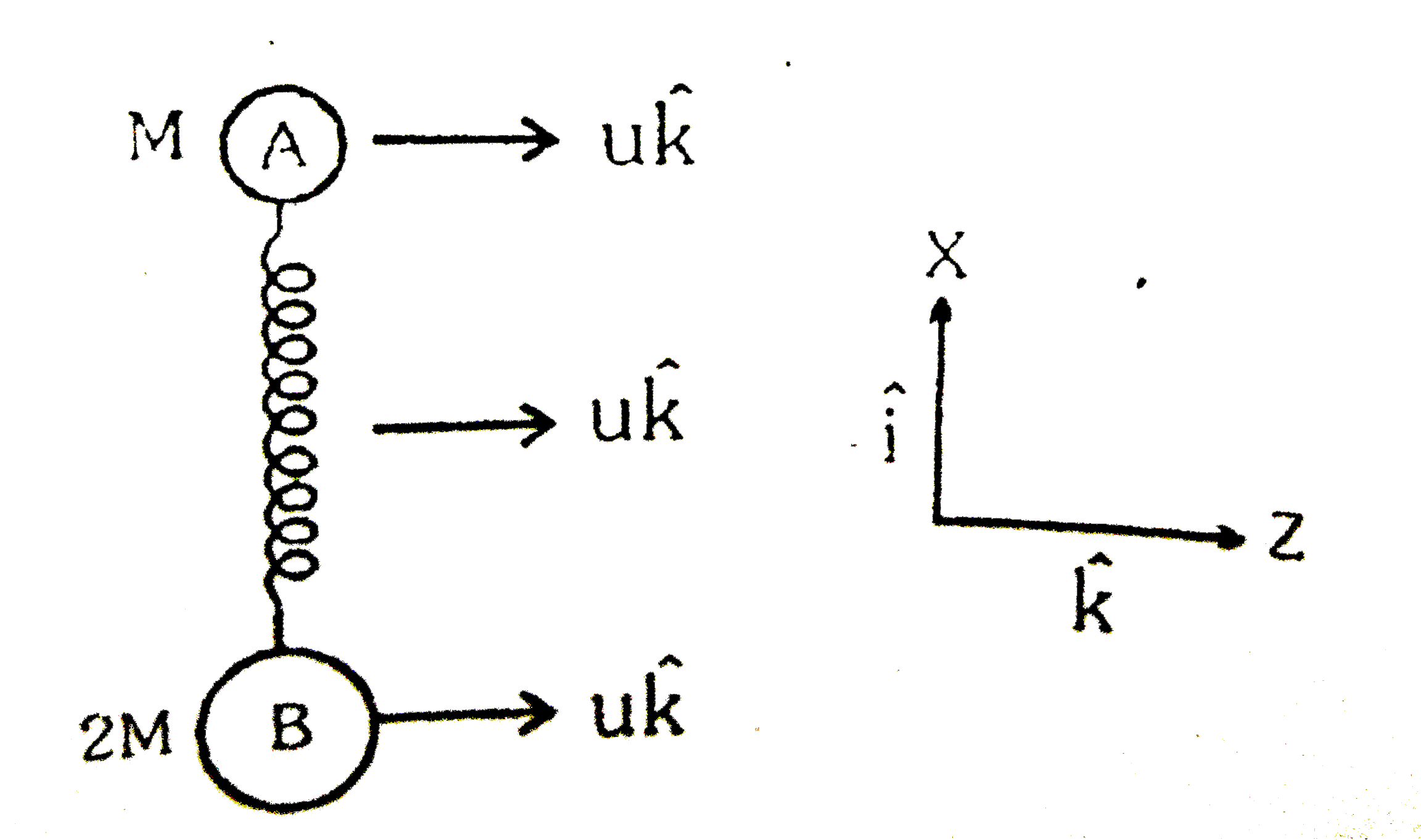 View Solution
View SolutionQuestion 33
A particle A of mass 100 g moving along +ve x-axis with 10m/sec, collides at origin, with particle B of mass 200 gm moving along +ve y-axis with 10m/sec. After collision the particle B moves along line 4x-3y=0 with speed with speed 5m/sec. The equation of line along which A moves after collision.View SolutionQuestion 35
Two identical balls A and B lie on a smooth horizontal surface, which gradually merges into a curve to a height 3.2m. Ball A is given a velocity of 10m/s, to collide head-on with ball B, which then takes up the curved path. What is the minimum coefficient of restitution, e, for the collision between A and B in order that ball B reaches the highest point C of the curve.
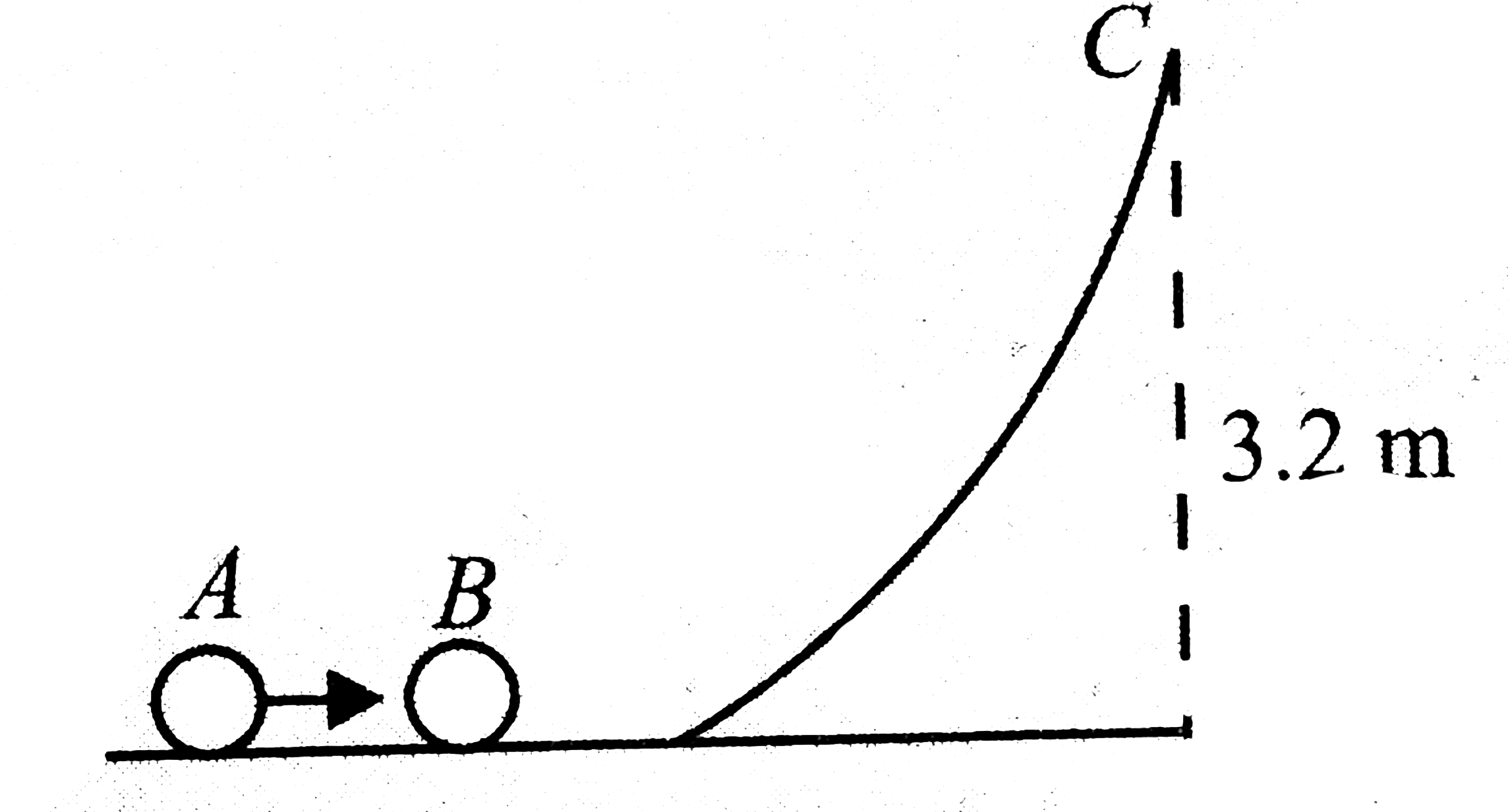 View Solution
View SolutionQuestion 37
On a smooth horizontal plane, a uniform string of mass M and length L is lying in the state of rest. A man of the same mass M is standing next to one end of the string. Now, the man starts collecting the string. Finally the man collects all the string and puts it in his pocket. What is the displacement of the man with respect to earth in the process of collection ?
 View Solution
View SolutionQuestion 39
In a smooth stationary cart of length d, a small block is projected along it's length with velocity υ towards front. Coefficient of restitution for each collision is e. The cart rests on a smooth ground and can move freely. The time taken by block to come to rest w.r.t. cart is :
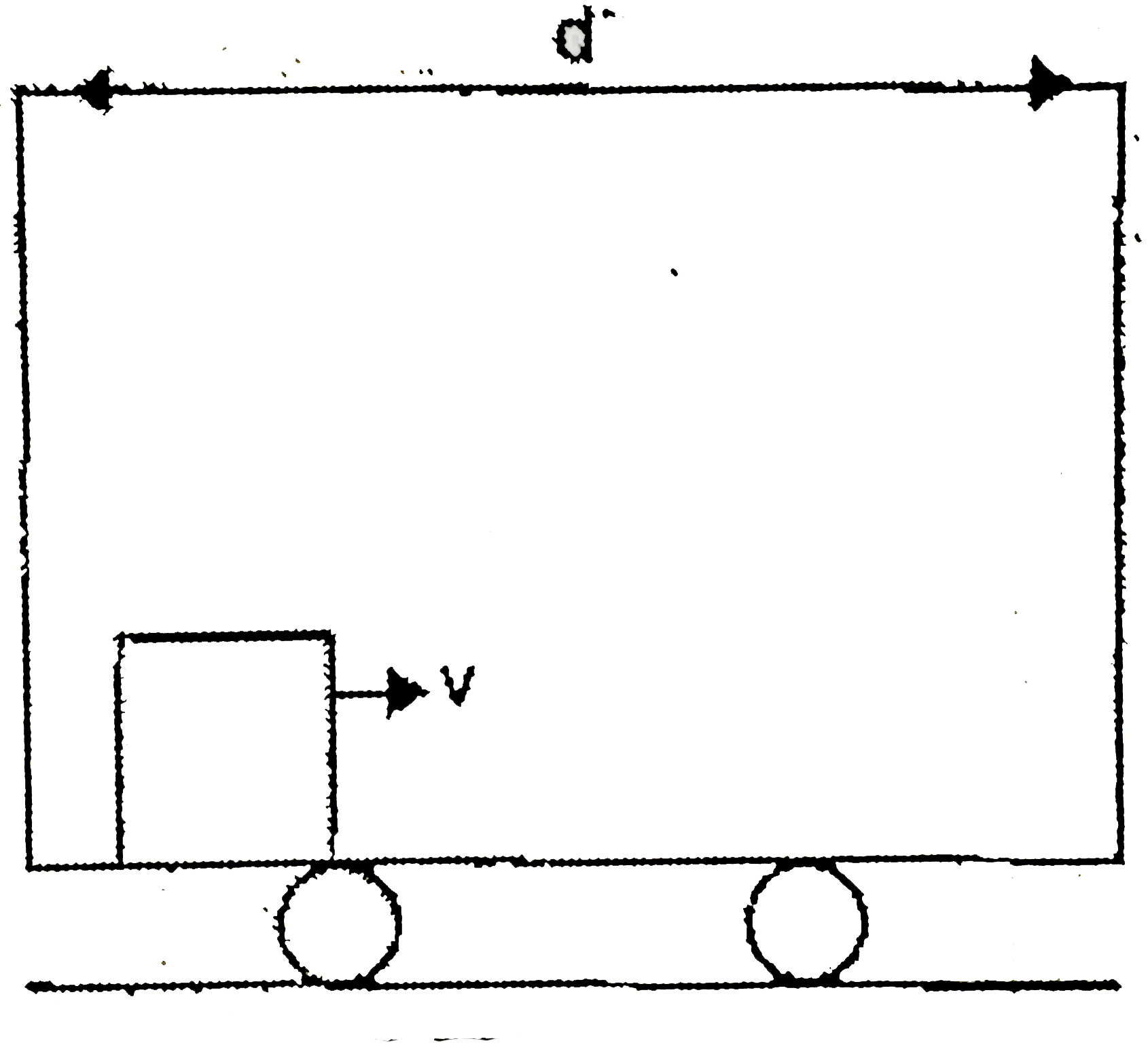 View Solution
View SolutionQuestion 42
The inclined sufaces of two movable wedges of same mass M are smoothly conjugated with the horizontal plane as shown in figure. A washer of mass m slides down the left wedge from a height h. To what maximum height will the washer rise along the right wedge ? Neglect friction.
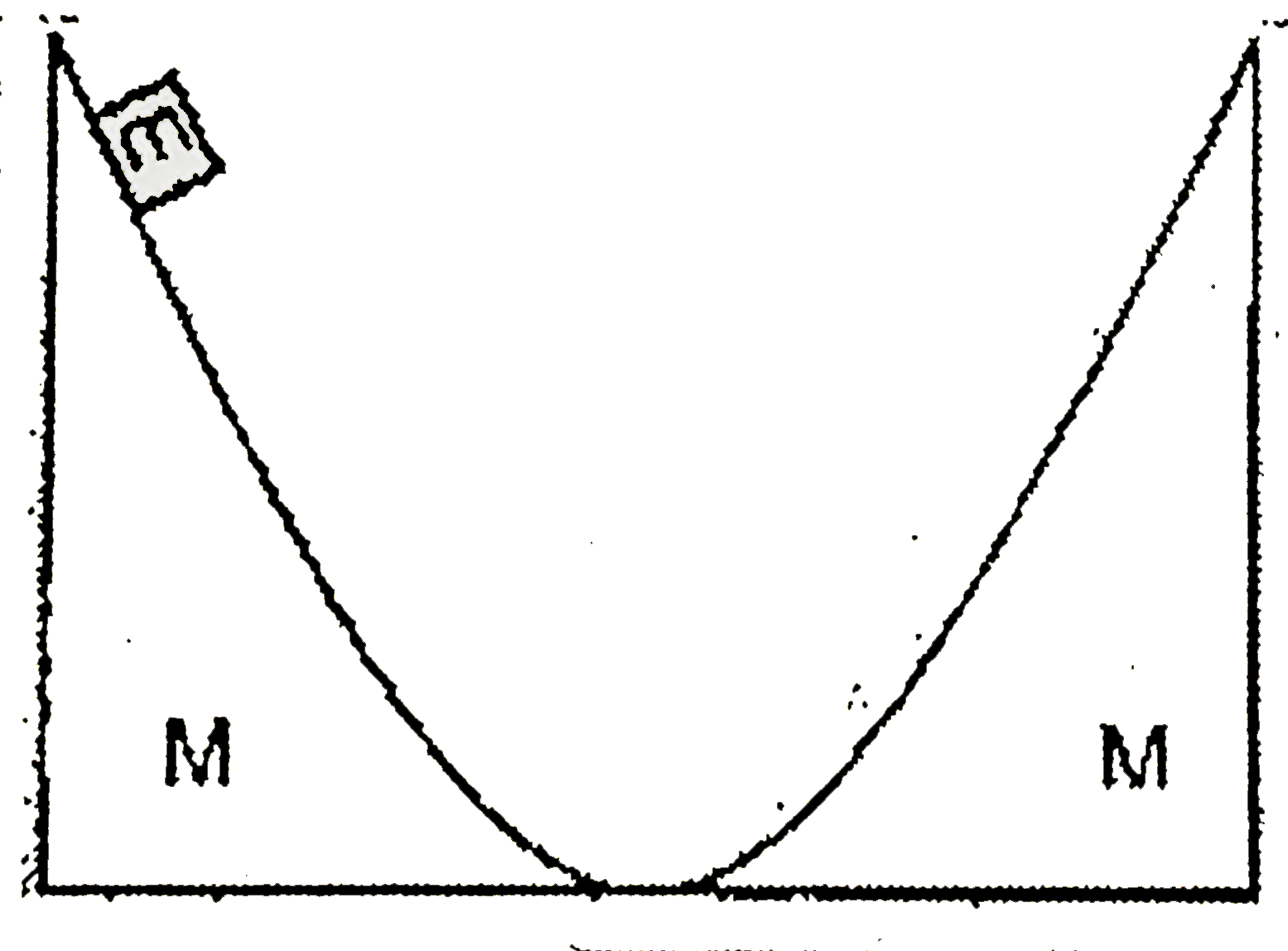 View Solution
View SolutionQuestion 43
In the arrangements shown in the figure masses of each ball is 1kg and mass of trolley is 4kg. In the figure, shell of mass 1kg moving horizontally with velocity v=6ms−1 collides with the ball and get stuck to it then its maximum deflection of the thread (length 1.5m) with vertical
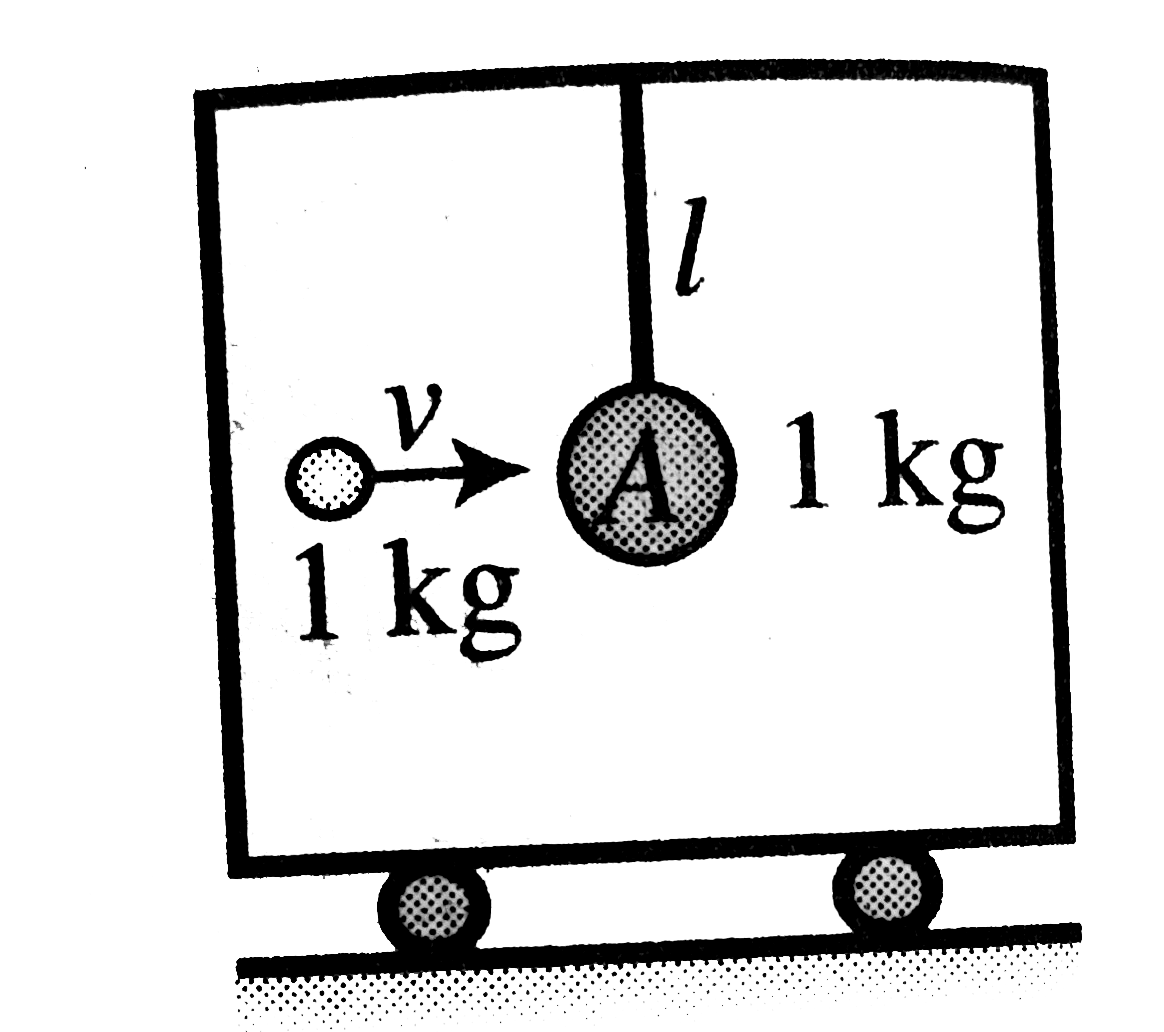 View Solution
View SolutionQuestion 45
A is a fixed point at height H above a perfectly inelastic smooth horizontal plane. A light inextesnsible string of length L(>H) has one end attached to A and other to a heavy particle. The particle is held at the level of A with string just taut and released from rest. Find the height of the particle above the plane when it is next instaneously at rest .
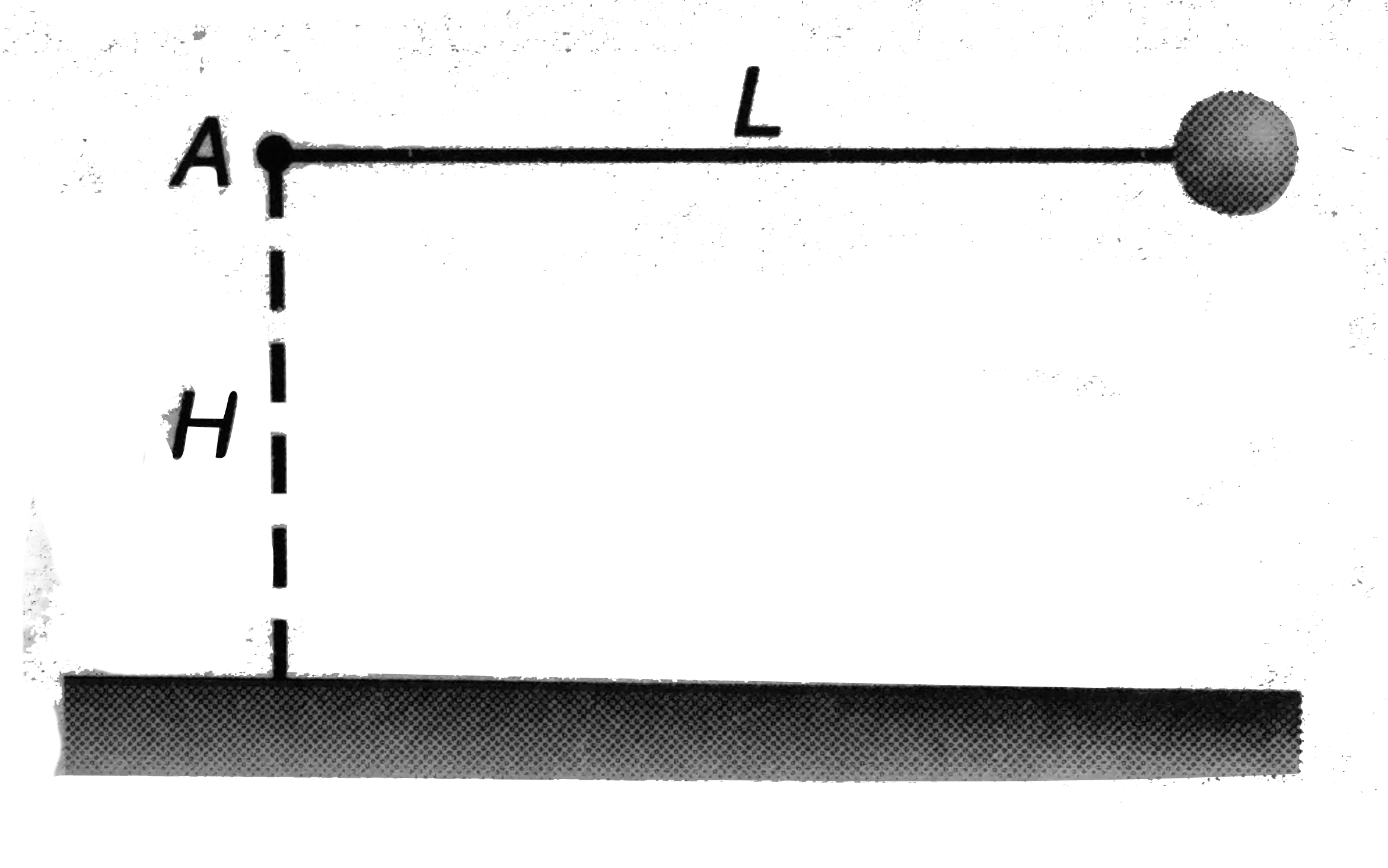 View Solution
View SolutionQuestion 46
A hemisphere of mass 3m and radius R is free to slide with its base on a smooth horizontal table. A particle of mass m is placed on the top of the hemisphere. If particle is displaced with a negligible velocity, then find the anuglar velocity of the particle relative to the centre of the hemisphere at an angular displacement θ, when velocity of hemisphere is υ.
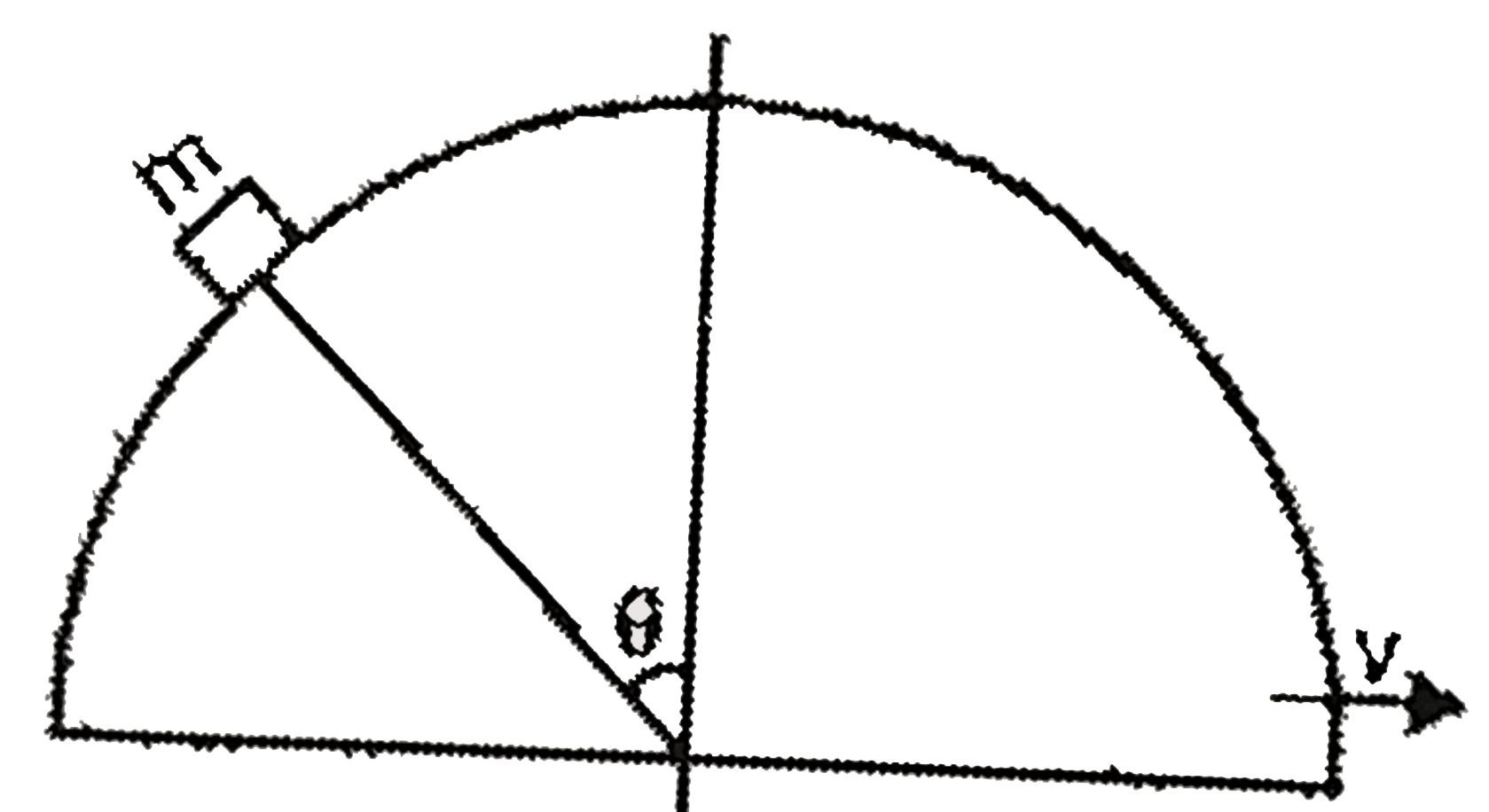 View Solution
View SolutionQuestion 51
A stationary pulley carries a rope whose one end supports a ladder with a man and the other end the counterweight of mass M. The man of mass m climbs up a distance l′ with respect to the ladder and then stops. Neglecting the mass of the rope and the friction in the pulley axle, find the displacement I of the centre of inertia of this system.View SolutionQuestion 55
Two identical balls are dropped from the same height onto a hard surface, the second ball being released exactly when the first ball bollides with the surface. If the first ball has made two more collisions by the time the second one collides. Then the coefficient of restitution between the ball and the surface satisfies :View SolutionQuestion 56
A bullet of mass 20 g travelling horizontally with a speed of 500 m/s passes through a wooden block of mass 10.0 kg initially at rest on a level surface. The bulet emerges with speed of 100 m/s and the block slides 20 cm on the surface before coming to rest. Find the friction cioefficient between the block and the surface figure.
 View Solution
View SolutionQuestion 57
A gun is mounted on a railroad car. The mass of the car, the gun, the shells and the operator is 50m where m is the mass of one shell. If the velocity of the shell with respect to the gun (in its state before firing) is 200 m/s, what is the recoil speed of the car after the second shot? Neglect friction.View SolutionQuestion 60
Three identical balls are connected by light inextensible strings with each other as shown and rest over a smooth horizontal table. Length of each string is l.
At moment t=0, ball B is imparted a velocity v0 perpendicular to the strings and then the system is left on its own.
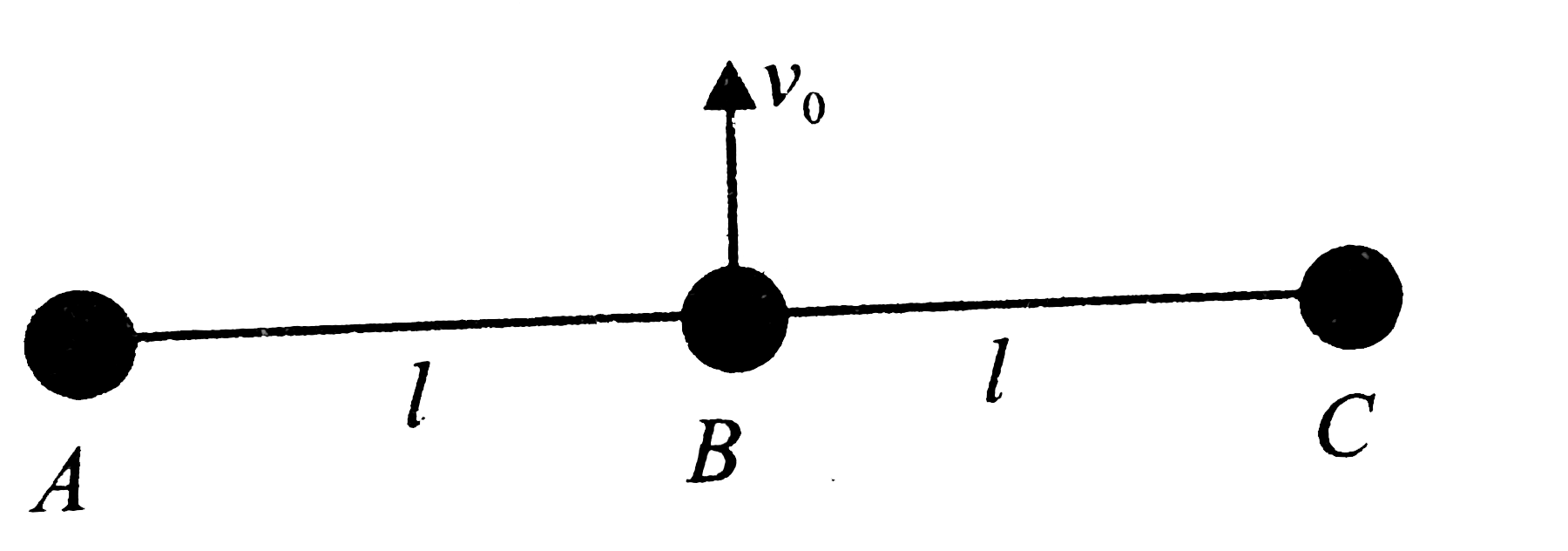
Calculate the velocity of B just before A collides with ball C. View SolutionQuestion 62
A box is put on a scale which is adusted to read zero when box is empty. A stream of pebbles is poured into the box from a height h above it's bottom at a rate μ pebbles/sec. each pebble has a mass m. Consider the collision between pebble and box to be completely inelastic. Find the reading of scale after t seconds of falling of pebbles.View SolutionQuestion 66
A 20g bullet pierces through a plate of mass M1=1kg and then comes to rest inside a second plate of mass M2=2.98kg as shown in Fig. It is found that the two plates, initially at rest, now move with equal velocities. Find the percentage loss in the initial velocity of the bullet when it is between M1 and M2. Neglect any loss of material of the plates due to the action of bullet.
 View Solution
View SolutionQuestion 68
A small disc of mass m slides down a smooth hill of height h without initial velocity and gets onto a plank of mass M lying on the horizontal plane at the base of the hill. (figure). Due to friction between the disc and the plank the disc slows down and, beginning with a certain moment, moves in one piece with the plank.
(1) Find the total work performed by the friction forces in this process.
(2) Can it be stated that the result of obtained does not depend on the choice of the reference frame?
 View Solution
View SolutionQuestion 72
A small sphere is moving at a constant speed in a vertical circle. Below is list of quantities that could be used to describe some aspect of the motion of the sphere.
I-kinetic energy
II- gravitational potential energy
III- momentum
Which of these quantities will change as this sphere moves around the circle ?View SolutionQuestion 76
A particle of mass 4m is projected from the ground at some angle with horizontal. Its horizontal range is R. At the highest point of its path it breaks into two pieces of masses m and 3m, respectively, such that the smaller mass comes to rest. The larger mass finally falls at a distance x from the point of projection, where x is equal to View SolutionQuestion 78
Two massless string of length 5 m hang from the ceiling very near to each other as shown in the figure. Two balls A and B of masses 0.25kg and 0.5kg are attached to the string. The ball A is released from rest at a height 0.45m as shown in the figure. The collision between two balls is completely elastic. Immediately after the collision, the kinetic energy of ball B is 1J The velocity of ball A just after the collision is
Q01.png) View Solution
View SolutionQuestion 93
A buggy of mass 100 kg is free to move on a frictionless horizontal track. Two men, each of mass 50 kg, are standing on the buggy, which is initially stationary. The men jump off the buggy with velocity =10m/s relative to the buggy. In one situation, the men jump one after the other. in another situation, the men jump simultaneously. what is the ratio of the velocities of the buggy in two cases?View SolutionQuestion 95
A billiard table whose length and width are as shown in the figure. A ball is placed at point A. at what angle θ the ball be projected so that after colliding with two walls, the ball will fall in the pocket B? assume that all collisions are perfectly elastic: (neglect friction)
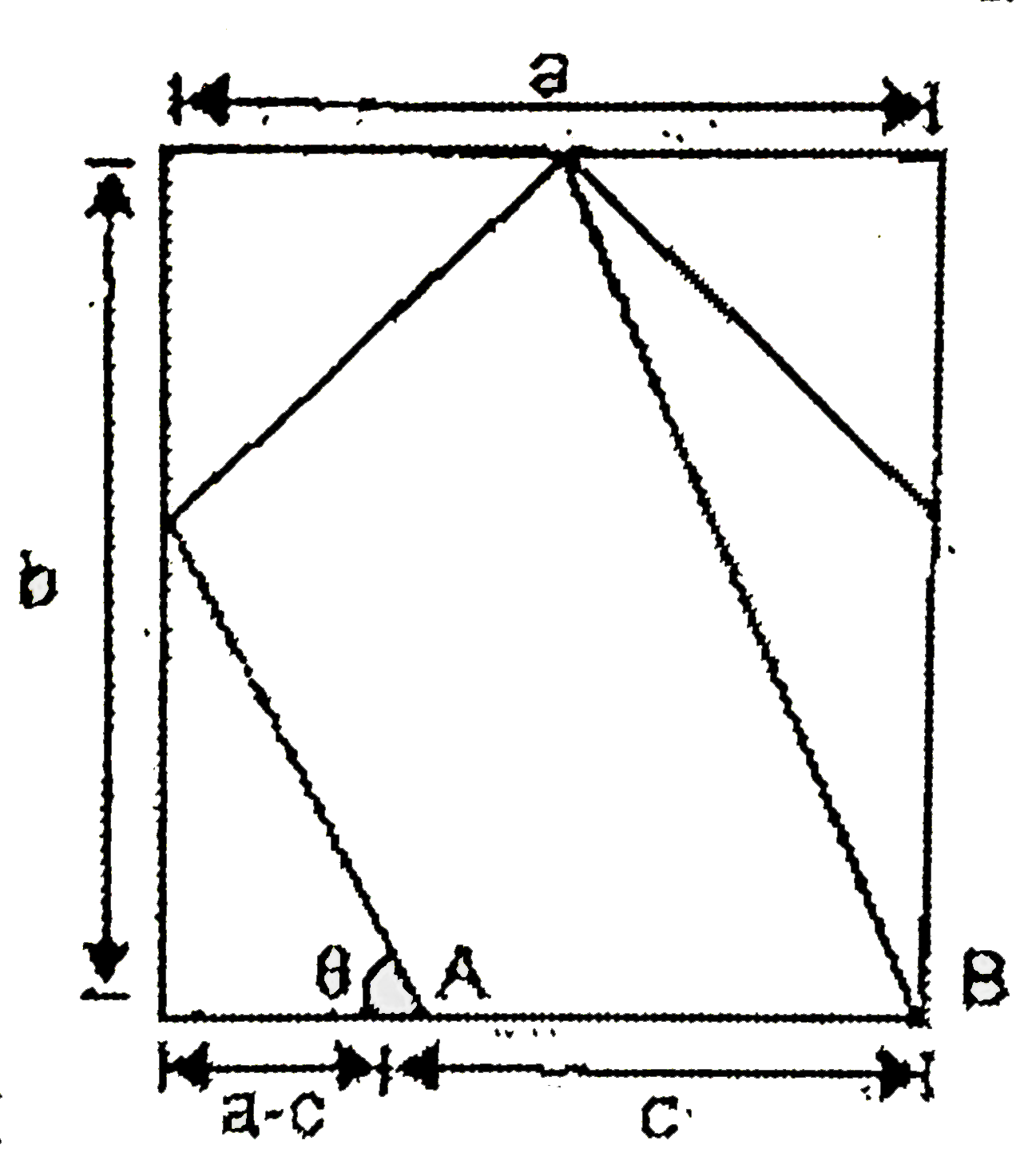 View Solution
View SolutionQuestion 97
A body of mass m is dropped from a height of h. Simultaneously another body of mass 2m is thrown up vertically with such a velocity v that they collide at height h2. If the collision is perfectly inelastic, the velocity of combined mass at the time of collision with the ground will be View SolutionQuestion 101
A flexible chain of length 2m and mass 1 kg initially held in vertical position such that its lower end just touches a horizontal surface, is released from rest at time t=0. Assuming that any part of chain which strikes the plane immediately comes to rest and that the portion of chain lying on horizontal surface does not from any heap, the height of its centre of mass above surface at any instant t=1√5 (before it completely comes to rest) isView SolutionQuestion 102
A parallel beam of particles of mass m moving with velocity v impinges on a wall at an angle θ to its normal. The number of particles per unit volume in the beam is n. If the collision of particles with the wall is elastic, then the pressure exerted by this beam on the wall is View SolutionQuestion 106
A block of mass m starts from rest and slides down a frictionless semi-circular track from a height h as shown. When it reaches the lowest point of the track, it collides with a stationary piece of putty also having mass in. If the block and the putty . stick together and continue to slide, the maximum height that the block-putty system could reach is
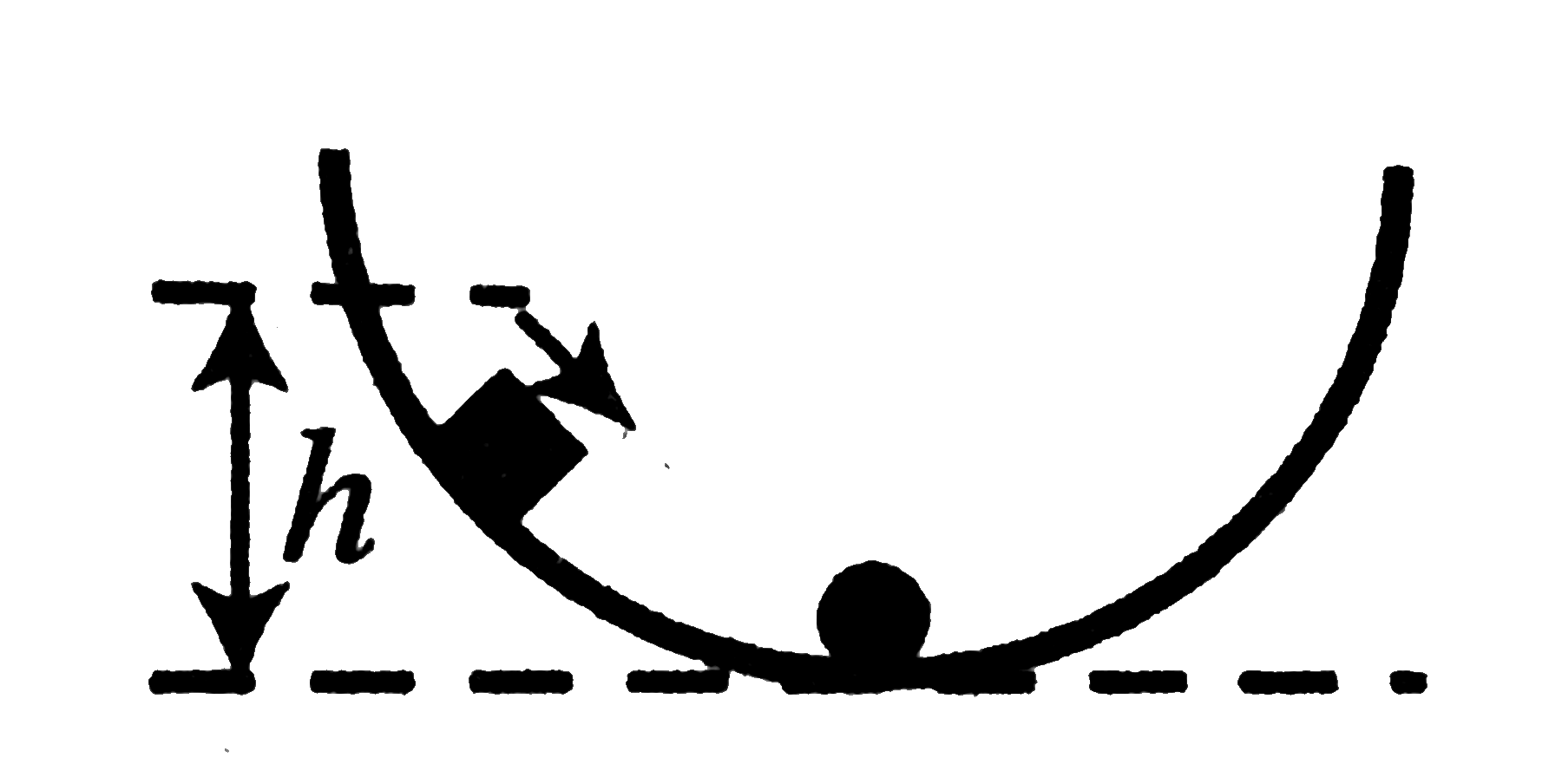 View Solution
View SolutionQuestion 107
Two billiard balls undergo a head-on collision. Ball 1 is twice as heavy as ball 2. Initially, ball 1 moves with a speed v towards ball 2 which is at rest. Immediately after the collision, ball 1 travels at a speed of v/3 in the same direction. What type of collision has occured?View SolutionQuestion 109
An isolated rail car of mass M is moving alonga straight, frictionless track at an initial speed v0. The car is passing under a bridge when a crate filled with N bowling balls, each of mass m, is dropped from the bridge into the bed of the rail car. the crate splits open and the bowling balls bounce around inside the rail car, but none of them fall out.
(A). Is the momentum of the ratil car+bowling balls system conserved in this collision?
View SolutionQuestion 110
An isolated rail car of mass M is moving alonga straight, frictionless track at an initial speed v0. The car is passing under a bridge when a crate filled with N bowling balls, each of mass m, is dropped from the bridge into the bed of the rail car. the crate splits open and the bowling balls bounce around inside the rail car, but none of them fall out.
(B).What is the average speed of the rail car + bowling balls system some time after the collision?View SolutionQuestion 111
A uniform chain of mass M and length L is held vertically in such a way that its lower end just touches the horizontal floor. The chain is released from rest in this position. Any portion that strikes the floor comes to rest. Assuming that the chain does not form a heap on the floor, calculate the force exerted by it on the floor when a length x has reached the floor.View SolutionQuestion 114
Two identical buggies move one after the other due to inertia (without friction) with the same velocity v0. A man of mass m rides the rear buggy. At a certain moment the man jumps into the front buggy with a velocity u relative to his buggy. Knowing that the mass of each buggy is equal to M, find the velocities with which the buggies will move after that. View SolutionQuestion 116
A small particle travelling with a velocity v collides elastically with a spbereical body of equal masss and of radius r initially kept at rest. The centre of this spherical body is located a distnce ρ(<r) away from the direction of motion of the particle figure. Find the final velocities of the two particles.
 View Solution
View SolutionQuestion 118
Two friends A and B (each weighing 40 kg) are sitting on a frictionless platform some distance d apart. A rolls a ball of mass 4 kg on the platform towards B which B catches. Then B rolls the ball towards A and A catches it. The ball keeps on moving back and forth between A and B. The ball has a fixed speed of 5 m/s on the platform. a. Find the speed of A after he rolls the ball for the first time. b. Find the speed of A after he catches the ball for the first time. c. Find the speed s of A and B after the ball has made 5 round trips and is held by A. d. How many times can A roll theball? e. where is the centre of mas the system A+B+ ball at the end of the nth trip?View SolutionQuestion 121
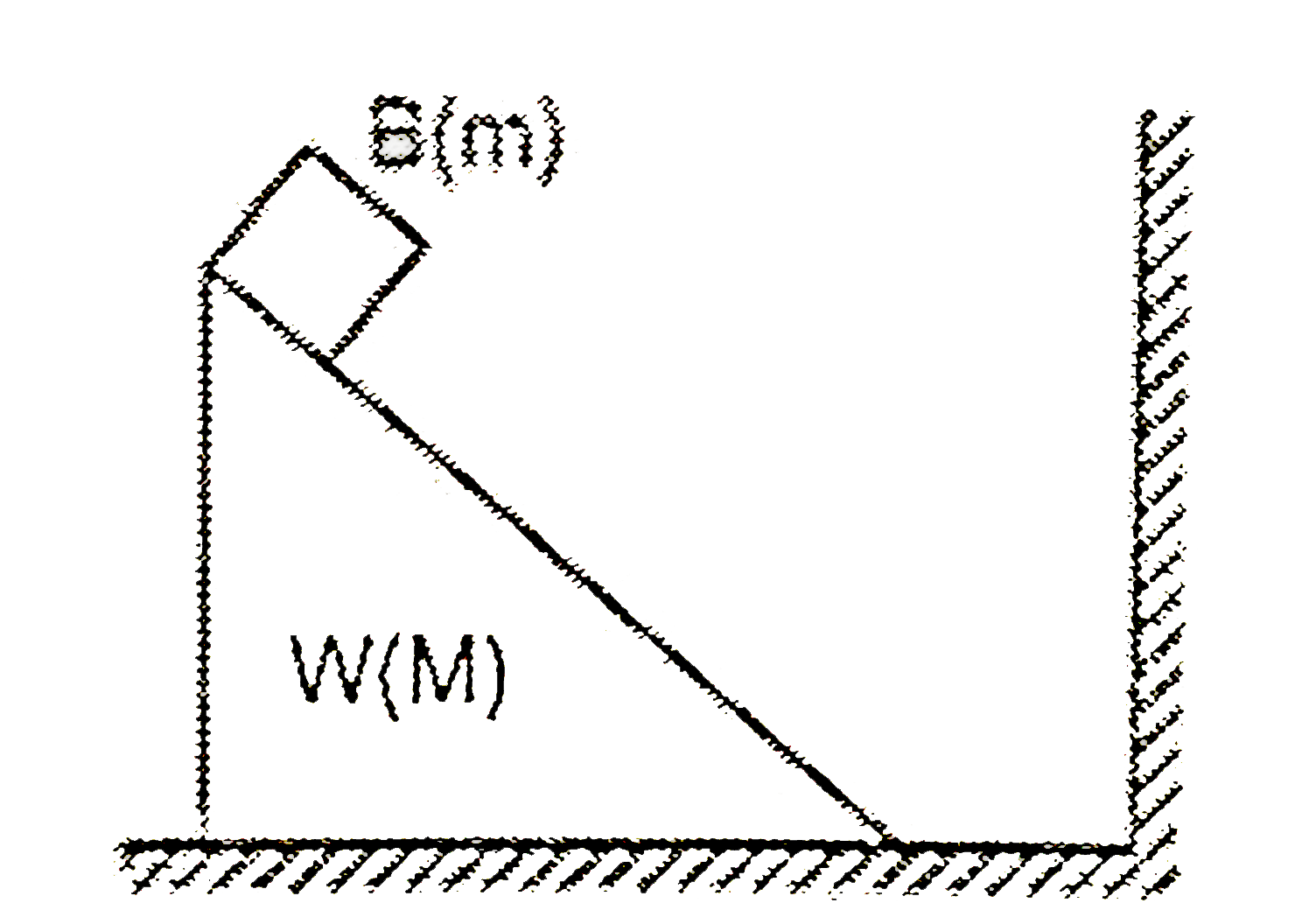
In the figure, the block B of mass m starts from rest at the top of a wedge W of mass M. All surfaces are without friction. W can slide on the ground. B slides down onto the ground, moves along it with a speed v, has an elastic collision with the wall, and climbs back two W. View SolutionQuestion 127
A ball of mass m=200gm is suspended from a point A by an inextensible string of length L. Ball is drawn to a side and held at same level as A but at a distance √32L from A as shown. Now the ball is released. Then :( assume string applies only that much jerk which is required so that velocity along string becomes zero ).
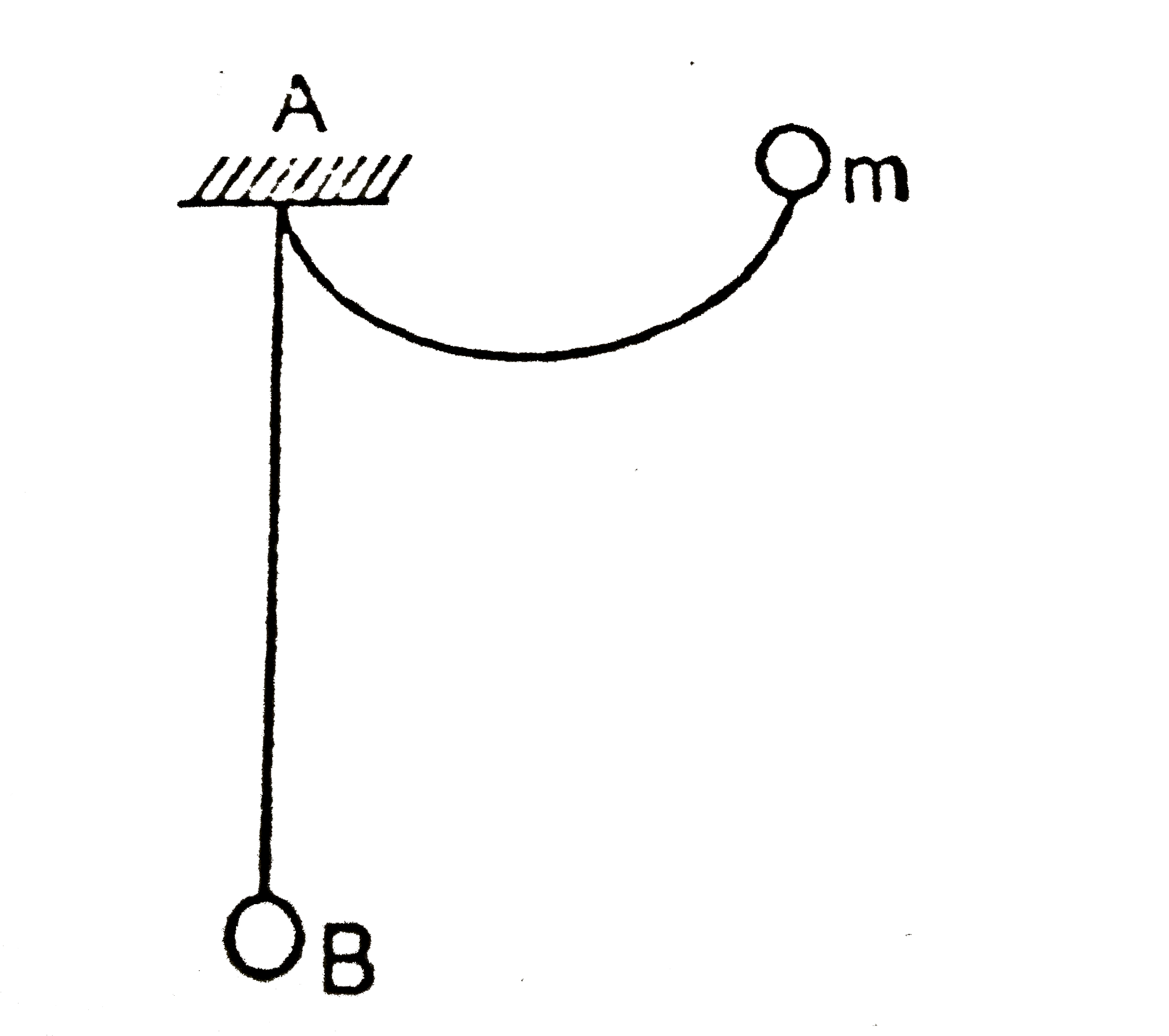 View Solution
View SolutionQuestion 132
While dealing with collision between particles, you must have deal from and Inertial reference frame Often we choose that frame to be fixed in the Laboratary in which the collision is observed. So it is called the Laboratary reference frame or Lab frame From Lab frame we define an elastic collision as a collision in which KE before and after collision is conserved and a perfectly inelastic collision as a collision in which after collision the two colliding bodies have same velocity vector along the line of action of impulse during collision.
If we discusss the head-on collsion between two particles from center of mass reference frame, then the velocity of center of mass (CM) will be taken to be zero in any type of collision i.e. velocity of CM before and after collision will both be zero. Since before collsion velocity of CM was zero (as our frame is fixed to CM) and no external impulse acts, it will remain zero forever
From CM frame, after a head-on elastic collision: View SolutionQuestion 133
While dealing with collision between particles, you must have deal from and Inertial reference frame Often we choose that frame to be fixed in the Laboratary in which the collision is observed. So it is called the Laboratary reference frame or Lab frame From Lab frame we define an elastic collision as a collision in which KE before and after collision is conserved and a perfectly inelastic collision as a collision in which after collision the two colliding bodies have same velocity vector along the line of action of impulse during collision.
If we discusss the head-on collsion between two particles from center of mass reference frame, then the velocity of center of mass (CM) will be taken to be zero in any type of collision i.e. velocity of CM before and after collision will both be zero. Since before collsion velocity of CM was zero (as our frame is fixed to CM) and no external impulse acts, it will remain zero forever
From CM frame, after a perfectly inelastic head-on collision:View SolutionQuestion 134
While dealing with collision between particles, you must have deal from and Inertial reference frame Often we choose that frame to be fixed in the Laboratary in which the collision is observed. So it is called the Laboratary reference frame or Lab frame From Lab frame we define an elastic collision as a collision in which KE before and after collision is conserved and a perfectly inelastic collision as a collision in which after collision the two colliding bodies have same velocity vector along the line of action of impulse during collision.
If we discusss the head-on collsion between two particles from center of mass reference frame, then the velocity of center of mass (CM) will be taken to be zero in any type of collision i.e. velocity of CM before and after collision will both be zero. Since before collsion velocity of CM was zero (as our frame is fixed to CM) and no external impulse acts, it will remain zero forever
Two particles of mass 2 kg and 1kg as shown in the figure make a perfectly inelastic collision. Then if we are dealing with center of mass reference frame, the velocity of B before collision is:
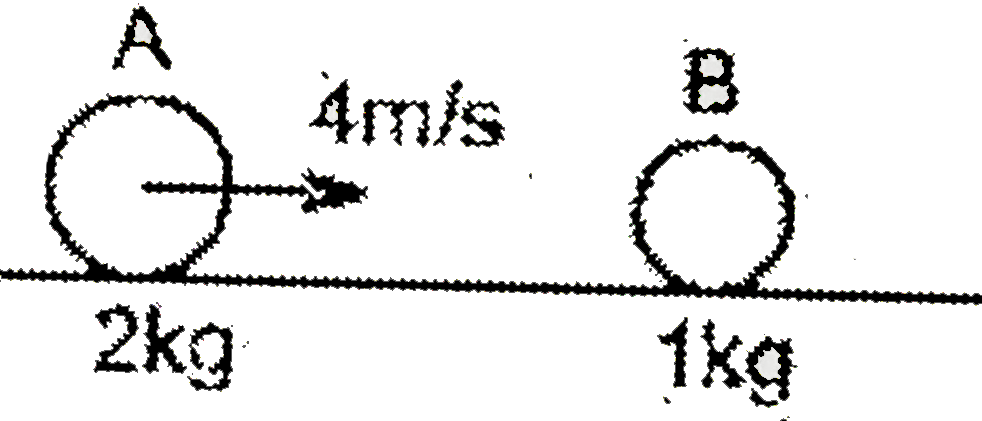 View Solution
View SolutionQuestion 135
While dealing with collision between particles, you must have deal from and Inertial reference frame Often we choose that frame to be fixed in the Laboratary in which the collision is observed. So it is called the Laboratary reference frame or Lab frame From Lab frame we define an elastic collision as a collision in which KE before and after collision is conserved and a perfectly inelastic collision as a collision in which after collision the two colliding bodies have same velocity vector along the line of action of impulse during collision.
If we discusss the head-on collsion between two particles from center of mass reference frame, then the velocity of center of mass (CM) will be taken to be zero in any type of collision i.e. velocity of CM before and after collision will both be zero. Since before collsion velocity of CM was zero (as our frame is fixed to CM) and no external impulse acts, it will remain zero forever
After collision, the velocity of B in CM reference frame will beView SolutionQuestion 136
While dealing with collision between particles, you must have deal from and Inertial reference frame Often we choose that frame to be fixed in the Laboratary in which the collision is observed. So it is called the Laboratary reference frame or Lab frame From Lab frame we define an elastic collision as a collision in which KE before and after collision is conserved and a perfectly inelastic collision as a collision in which after collision the two colliding bodies have same velocity vector along the line of action of impulse during collision.
If we discusss the head-on collsion between two particles from center of mass reference frame, then the velocity of center of mass (CM) will be taken to be zero in any type of collision i.e. velocity of CM before and after collision will both be zero. Since before collsion velocity of CM was zero (as our frame is fixed to CM) and no external impulse acts, it will remain zero forever
If collision were elastic in above question then velocity of B after collision in CM reference frame will be: View SolutionQuestion 137
Two blocks each of, mass m=1 kg are connected with each other by a flexible light and frictionless pulley. At t = 0 an inelastic ball of, mass 'm'=1 collides from bottom with the block A with velocity v0=16 m/sec vertically upwards, On the basis of above information. Answer the following questions.
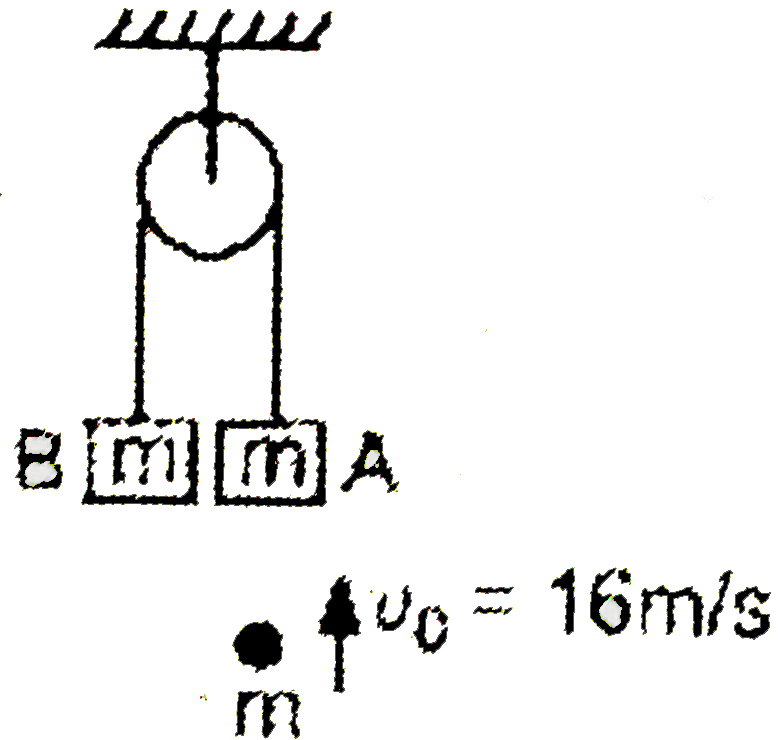
The velocity of blocks just after collision in m/sec is:View SolutionQuestion 138
Two blocks each of, mass m=1 kg are connected with each other by a flexible light and frictionless pulley. At t = 0 an inelastic ball of, mass 'm'=1 collides from bottom with the block A with velocity v0=16 m/sec vertically upwards, On the basis of above information. Answer the following questions.
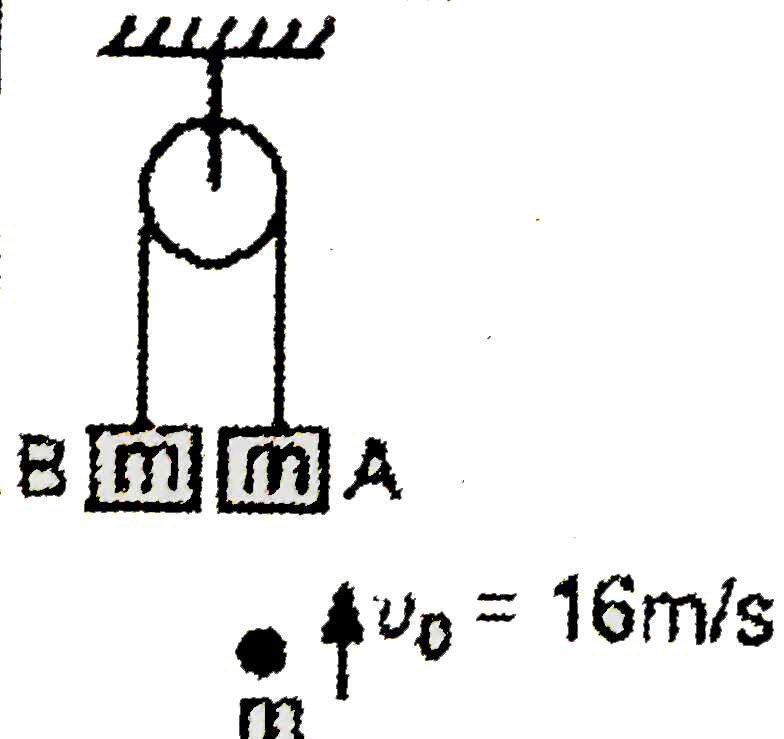
The acceleration of both the blocks just after collision in m/sec2 is: View SolutionQuestion 139
Two blocks each of, mass m=1 kg are connected with each other by a flexible light and frictionless pulley. At t = 0 an inelastic ball of, mass 'm'=1 collides from bottom with the block A with velocity v0=16 m/sec vertically upwards, On the basis of above information. Answer the following questions.

The time after which string become tight is at t = ......... seconds: View SolutionQuestion 140
Two blocks each of, mass m=1 kg are connected with each other by a flexible light and frictionless pulley. At t = 0 an inelastic ball of, mass 'm'=1 collides from bottom with the block A with velocity v0=16 m/sec vertically upwards, On the basis of above information. Answer the following questions.
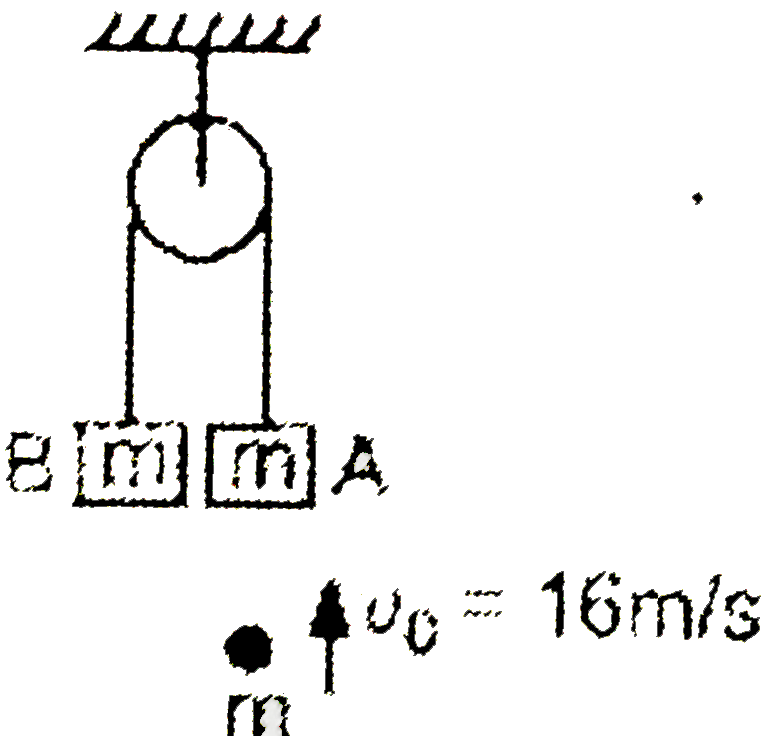
Velocity of block A just before string becomes tight will: View SolutionQuestion 141
Two blocks each of, mass m=1 kg are connected with each other by a flexible light and frictionless pulley. At t = 0 an inelastic ball of, mass 'm'=1 collides from bottom with the block A with velocity v0=16 m/sec vertically upwards, On the basis of above information. Answer the following questions.
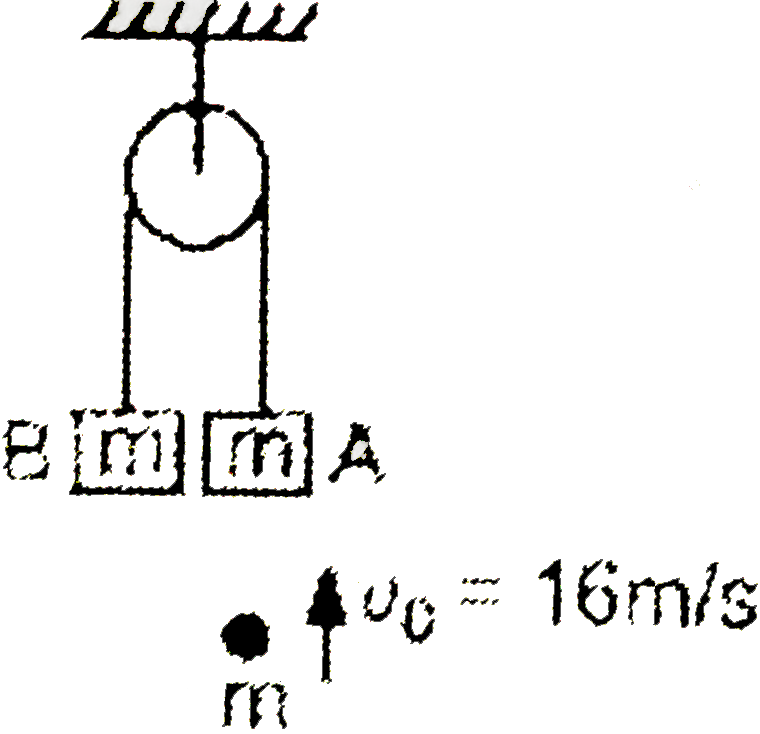
The maximum height up to which blockA reaches is: View SolutionQuestion 142
Two blocks each of, mass m=1 kg are connected with each other by a flexible light and frictionless pulley. At t = 0 an inelastic ball of, mass 'm'=1 collides from bottom with the block A with velocity v0=16 m/sec vertically upwards, On the basis of above information. Answer the following questions.
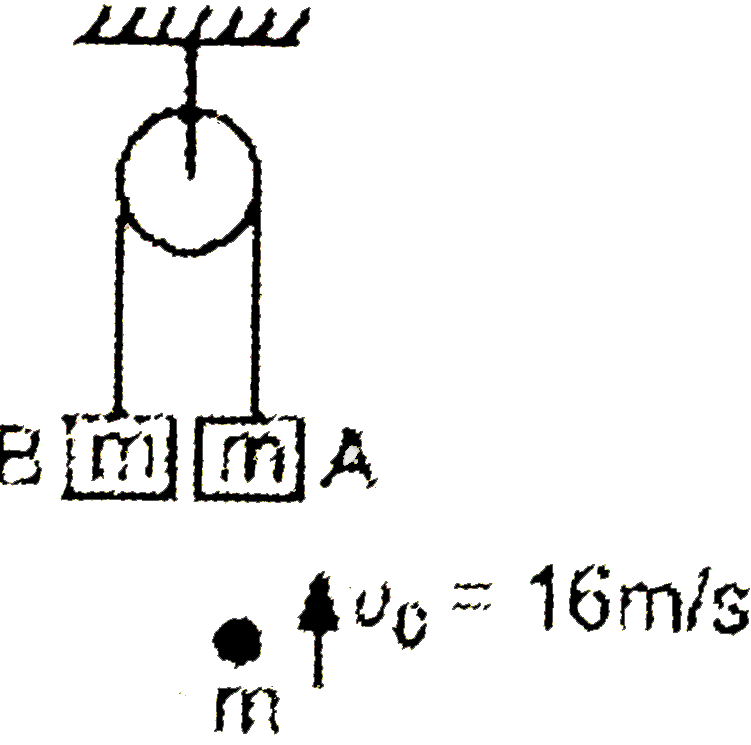
The velocity of both the blocks just after string become tight in m/sec. View SolutionQuestion 143
Two blocks each of, mass m=1 kg are connected with each other by a flexible light and frictionless pulley. At t = 0 an inelastic ball of, mass 'm'=1 collides from bottom with the block A with velocity v0=16 m/sec vertically upwards, On the basis of above information. Answer the following questions.
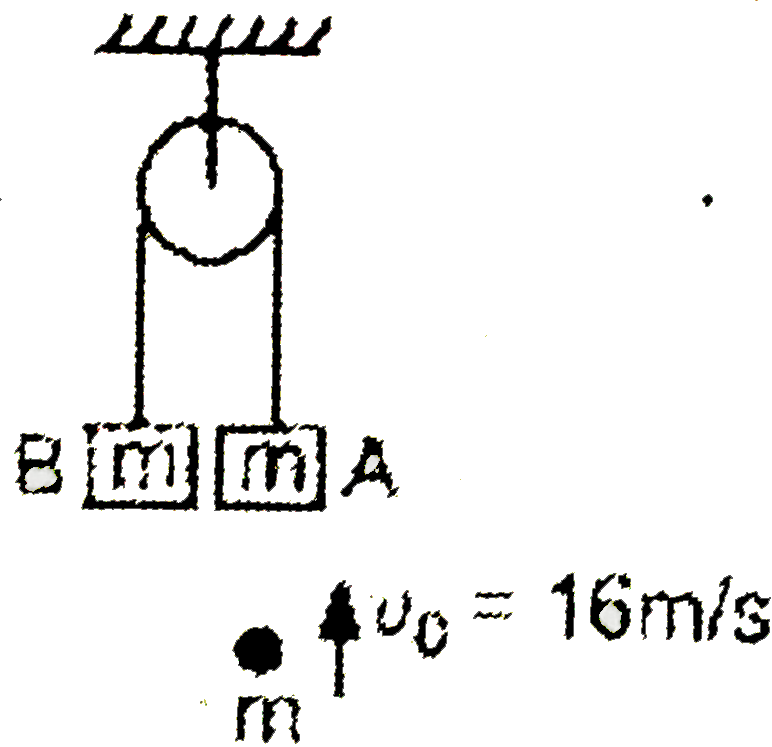
Acceleration of the two blocks just after string become tight in m/sec2: View SolutionQuestion 144
Two blocks each of, mass m=1 kg are connected with each other by a flexible light and frictionless pulley. At t = 0 an inelastic ball of, mass 'm'=1 collides from bottom with the block A with velocity v0=16 m/sec vertically upwards, On the basis of above information. Answer the following questions.
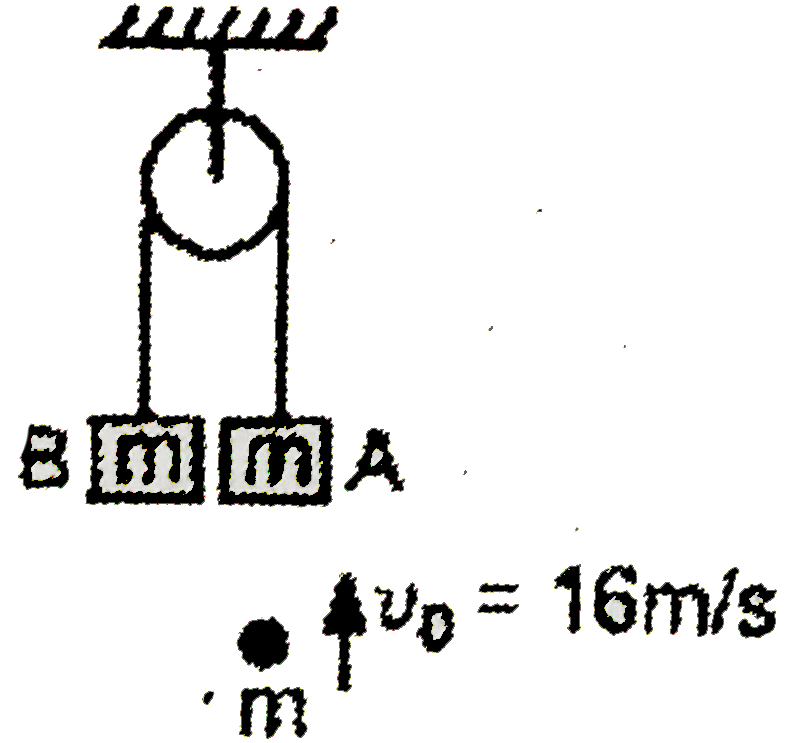
Energy loss due to the impulse applied by string in joule is :View SolutionQuestion 145
Two blocks each of, mass m=1 kg are connected with each other by a flexible light and frictionless pulley. At t = 0 an inelastic ball of, mass 'm'=1 collides from bottom with the block A with velocity v0=16 m/sec vertically upwards, On the basis of above information. Answer the following questions.

The graphical representation of modulus of velocity of block B is correctly shown in:View SolutionQuestion 149
A block of mass 2 m collides,elastically with a masss m kept at rest. Friction exists between the block B ,and surface with coefficientμ=0.3, whereas no.friction exists between block A and the surface.
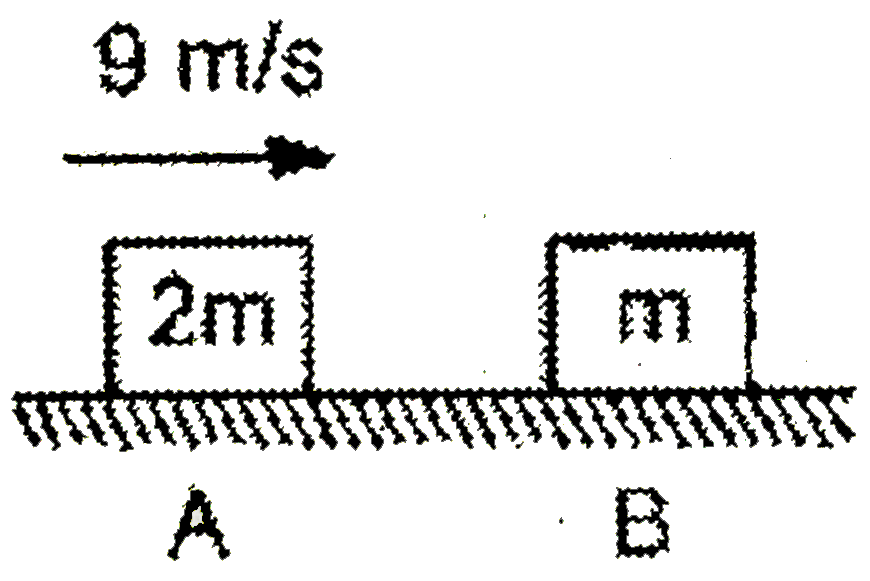
After how much time collision between the blocks will not take place practically:View SolutionQuestion 150
A block of mass 2 m collides,elastically with a masss m kept at rest. Friction exists between the block B ,and surface with coefficientμ=0.3, whereas no.friction exists between block A and the surface.
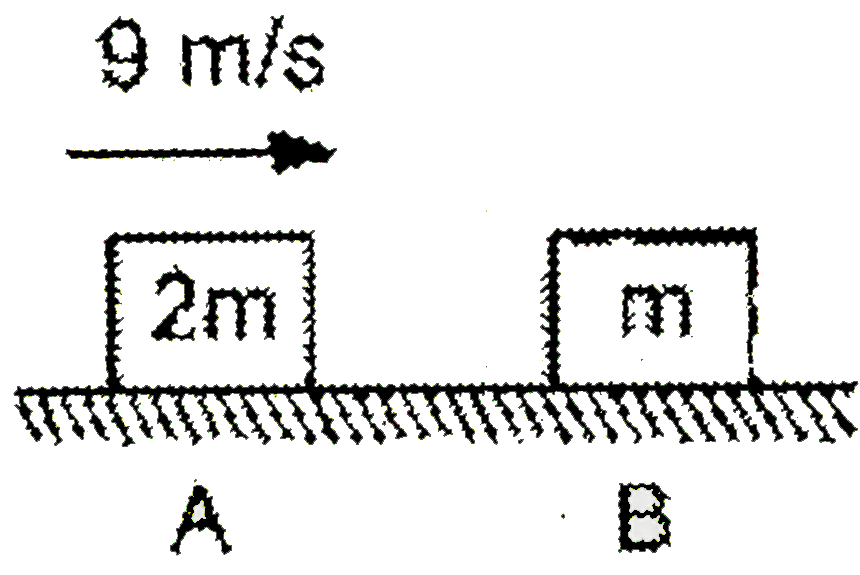
Maximum distance between the blocks during the time interval between first and second collision is: View SolutionQuestion 151
A block of mass 2 m collides,elastically with a masss m kept at rest. Friction exists between the block B ,and surface with coefficientμ=0.3, whereas no.friction exists between block A and the surface.

Which of the following graphs best represent the distance between the blocks between first and second collision? View SolutionQuestion 152
Comprehension # 5
One particle of mass 1kg is moving along positive x-axis with velocity 3m/s. Another particle of mass 2kg is moving along y-axis with 6m/s. At time t=0,1kg mass is at (3m,0) and 2kg at (0,9m),x−y plane is the horizontal plane. (Surface is smooth for question 1 and rough for question 2 and 3)
The centre of mass of the two particles is moving in a straight line for which equation is :View SolutionQuestion 153
Comprehension # 5
One particle of mass 1kg is moving along positive x-axis with velocity 3m/s. Another particle of mass 2kg is moving along y-axis with 6m/s. At time t=0,1kg mass is at (3m,0) and 2kg at (0,9m),x−y plane is the horizontal plane. (Surface is smooth for question 1 and rough for question 2 and 3)
If both the particles have the same value of coefficient of friction μ=0.2. The centre of mass will stop at time t= ..........s :-View SolutionQuestion 154
Comprehension # 5
One particle of mass 1kg is moving along positive x-axis with velocity 3m/s. Another particle of mass 2kg is moving along y-axis with 6m/s. At time t=0,1kg mass is at (3m,0) and 2kg at (0,9m),x−y plane is the horizontal plane. (Surface is smooth for question 1 and rough for question 2 and 3)
Co-ordinates of centre of mass where it will stop finally are :-View SolutionQuestion 155
A small ball B of mass m is suspended with light inelastic string of length L from a block A of same mass in which can move on smooth horizontal surface as shown in the figure. The ball is displaced by angle θ from equilibrium position and then released.
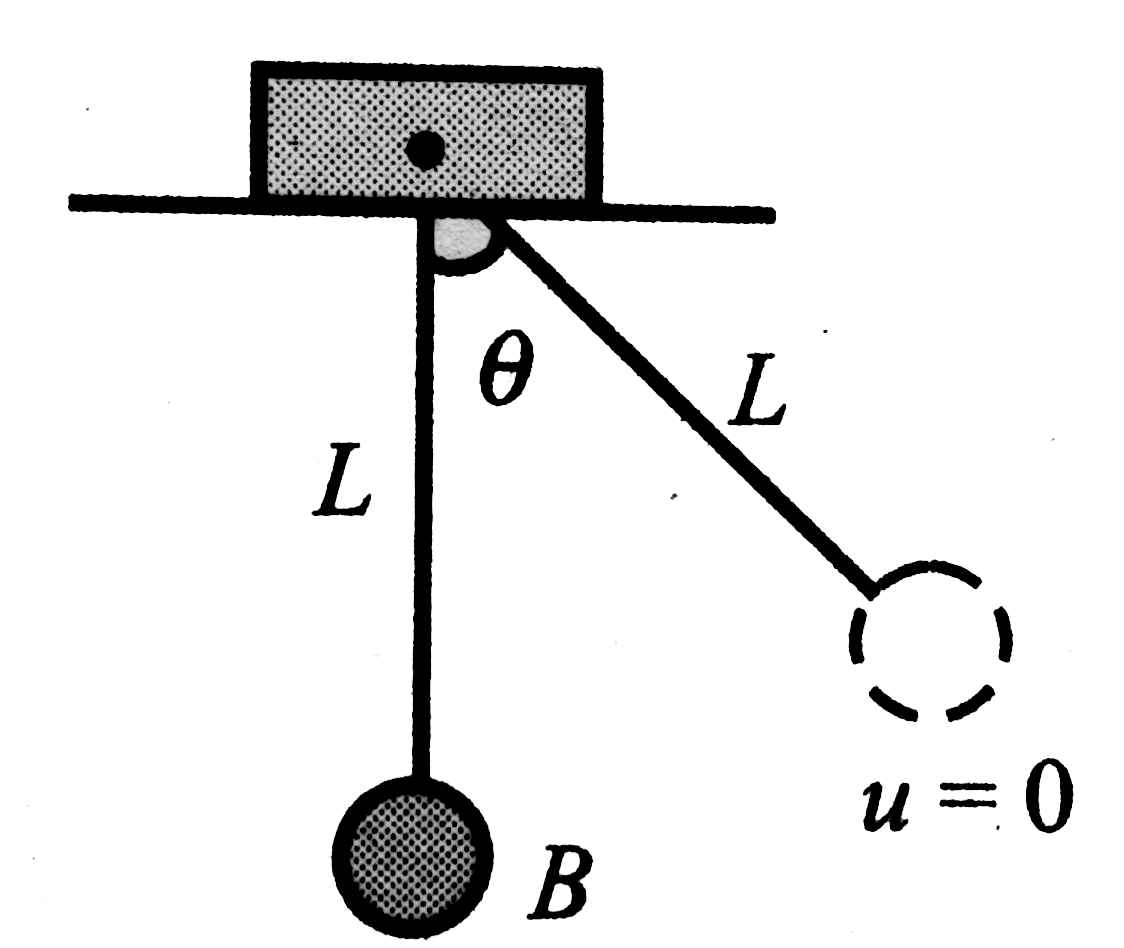
The displacement of block when equilibrium position is View SolutionQuestion 156
A small ball B of mass m is suspended with light inelastic string of length L from a block A of same mass in which can move on smooth horizontal surface as shown in the figure. The ball is displaced by angle θ from equilibrium position and then released.
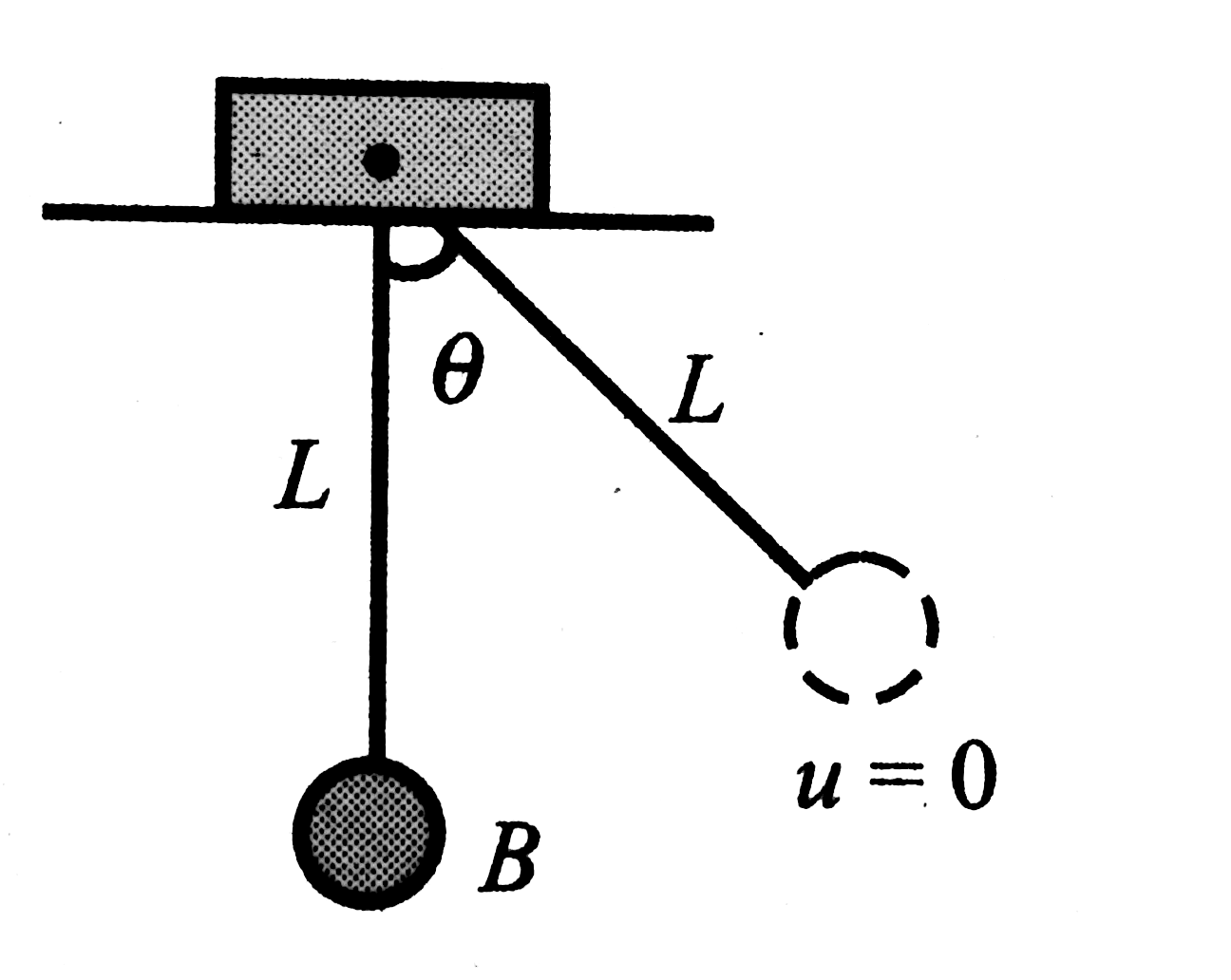
Tension in string when it is vertical, is View SolutionQuestion 157
A small ball B of mass m is suspended with light inelastic string of length L from a block A of same mass in which can move on smooth horizontal surface as shown in the figure. The ball is displaced by angle θ from equilibrium position and then released.
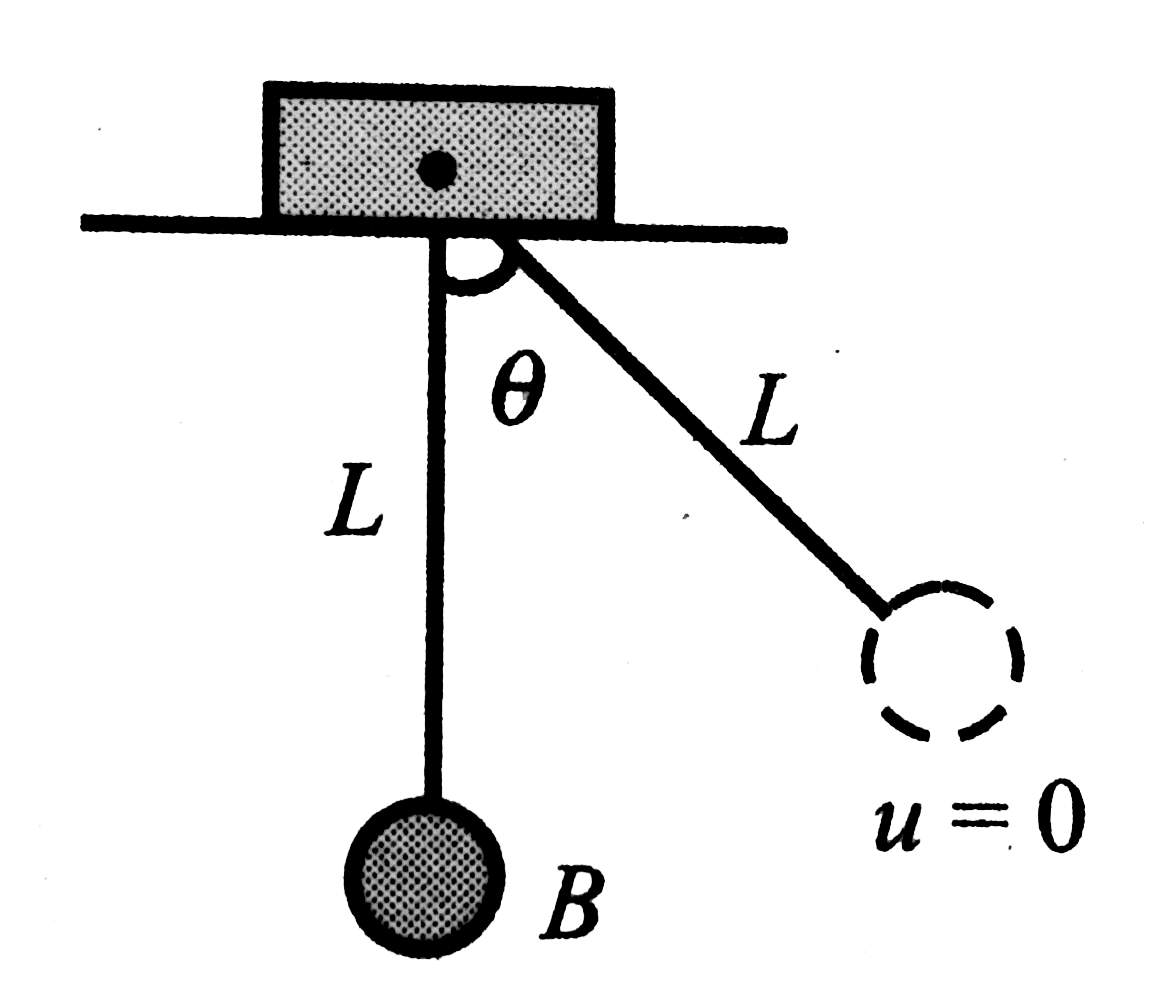
Maximum velocity of block during subsequent motion of the system after release of ball isView SolutionQuestion 158
A small ball B of mass m is suspended with light inelastic string of length L from a block A of same mass in which can move on smooth horizontal surface as shown in the figure. The ball is displaced by angle θ from equilibrium position and then released.
 The displacement of centre of mass of A+B system till the string becomes vertical is View Solution
The displacement of centre of mass of A+B system till the string becomes vertical is View SolutionQuestion 159
The figure shows a man of mass m standing at the end A of a trolley of maas M placed at rest on a smooth horizontal surface. The man starts moving towards the end B with a velocity urel with respect to the trolley. The length of the trolley is L.
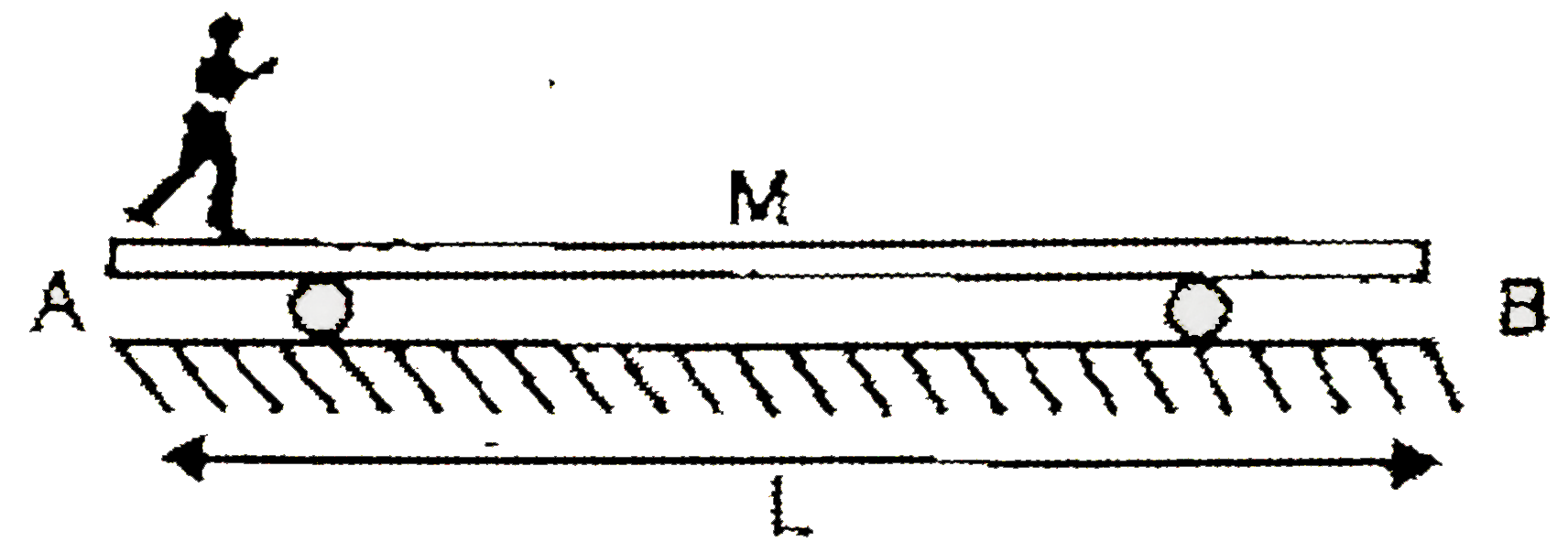
When the man starts moving, then the velocity of the trolley v2 with respect to ground will be: View SolutionQuestion 160
The figure shows a man of mass m standing at the end A of a trolley of maas M placed at rest on a smooth horizontal surface. The man starts moving towards the end B with a velocity urel with respect to the trolley. The length of the trolley is L.

The velocity of the man with respect to ground v1 will be:View SolutionQuestion 161
The figure shows a man of mass m standing at the end A of a trolley of maas M placed at rest on a smooth horizontal surface. The man starts moving towards the end B with a velocity urel with respect to the trolley. The length of the trolley is L.
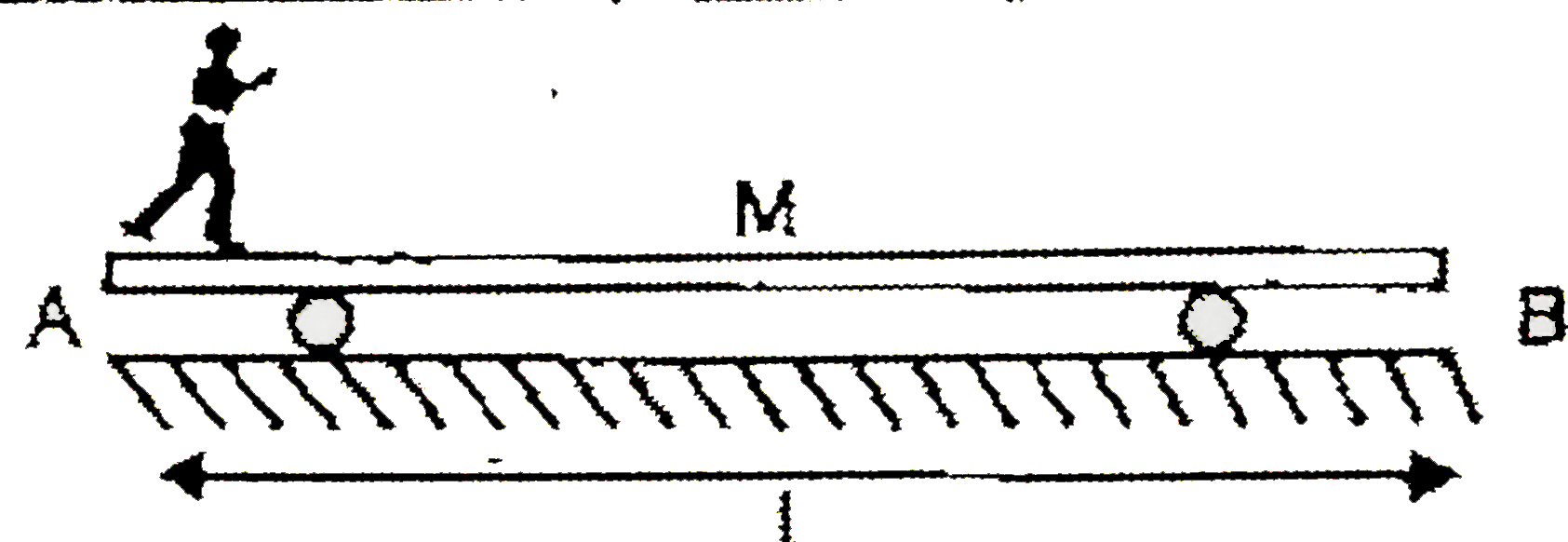
The time taken by the man to reach the other end is: View SolutionQuestion 162
The figure shows a man of mass m standing at the end A of a trolley of maas M placed at rest on a smooth horizontal surface. The man starts moving towards the end B with a velocity urel with respect to the trolley. The length of the trolley is L.
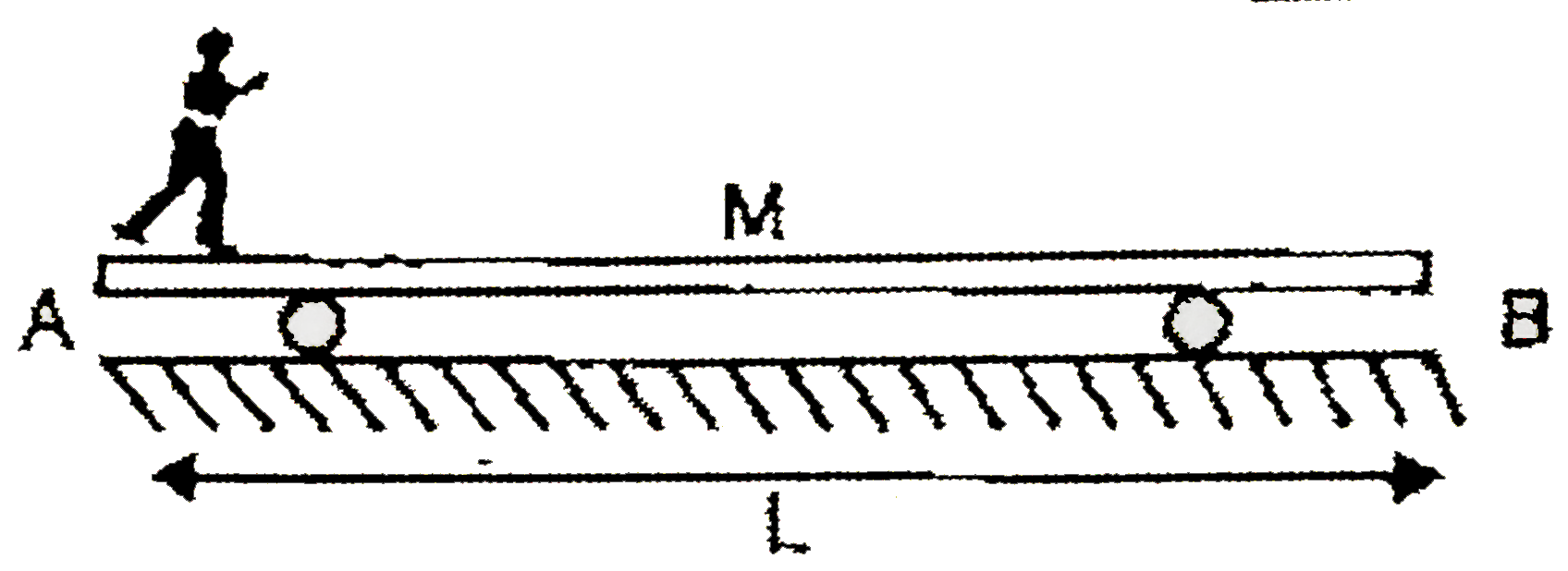
As the man walks on the trolley, the centre of mass of the system (man+ trolley) :View SolutionQuestion 163
The figure shows a man of mass m standing at the end A of a trolley of maas M placed at rest on a smooth horizontal surface. The man starts moving towards the end B with a velocity urel with respect to the trolley. The length of the trolley is L.
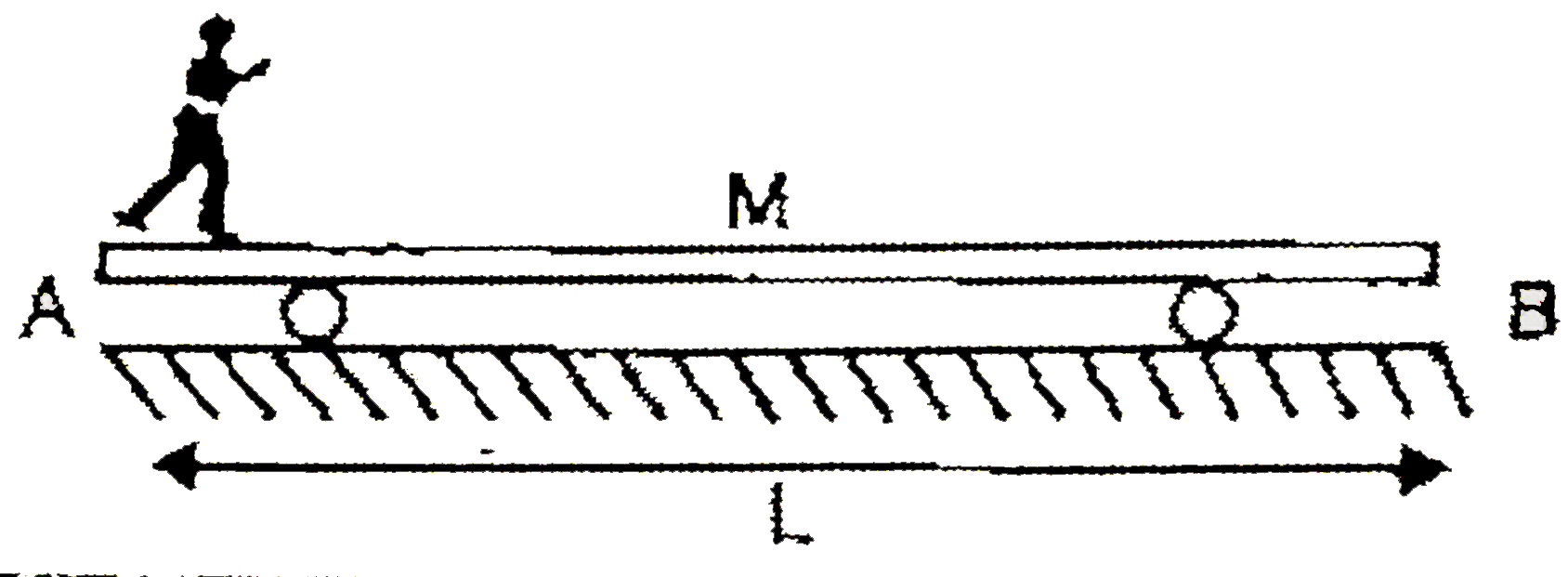
When the man reaches the end B, the distance moves . by the trolley with respect to ground is: View SolutionQuestion 164
The figure shows a man of mass m standing at the end A of a trolley of maas M placed at rest on a smooth horizontal surface. The man starts moving towards the end B with a velocity urel with respect to the trolley. The length of the trolley is L.
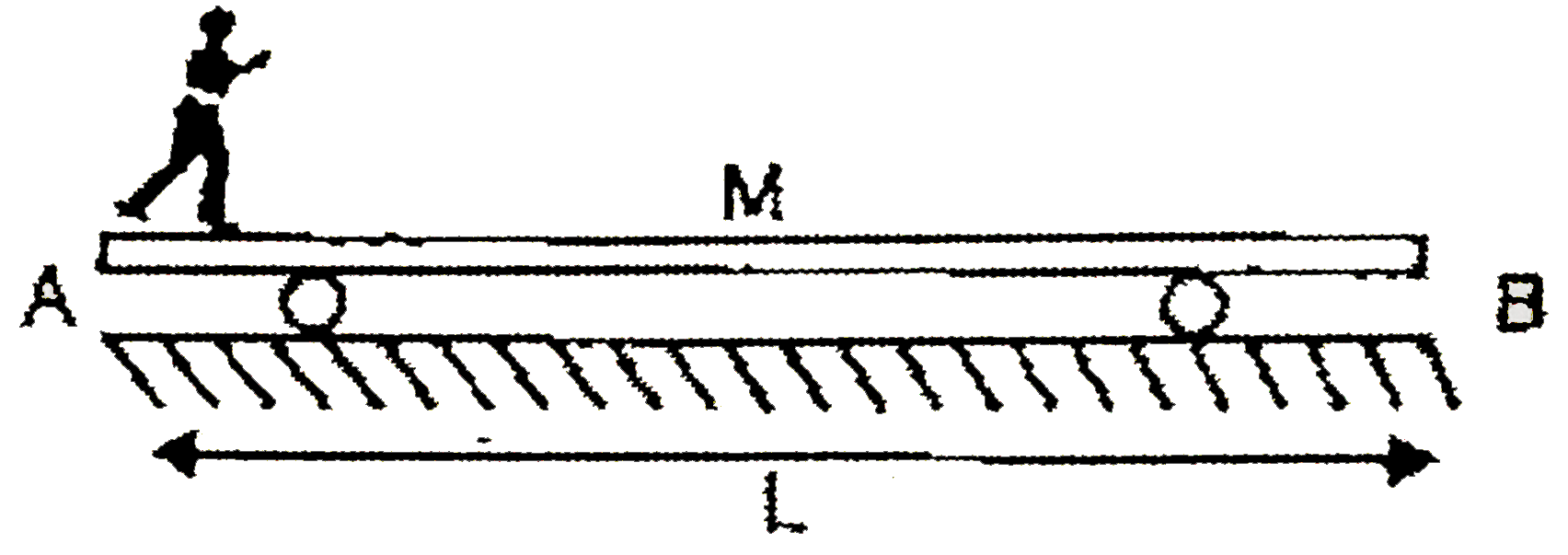
Choose the correct statement: View SolutionQuestion 165
The figure shows a man of mass m standing at the end A of a trolley of maas M placed at rest on a smooth horizontal surface. The man starts moving towards the end B with a velocity urel with respect to the trolley. The length of the trolley is L.

Choose the correct statement: View SolutionQuestion 171
A projectile of mass 3kg is projected with velocity 50m/s at 37∘ from horizontal. After 2s, explosion takes place and the projectile breaks into two parts of masses 1kg and 2kg. The first part comes to rest just after explosion.
Find,
(a) the velocity of second part just after explosion.
(b) maximum height attained by this part. Take g=10m/s2View SolutionQuestion 172
A projectile of mass "m" is projected from ground1 with a speed of 50 m/s at an angle of 53∘ with the horizontal. It breaks up into two equal parts at the highest point of the trajectory. One particle coming to rest immediately after the explosion.
The distance between the pieces of the projectile when they reach the ground are : View SolutionQuestion 173
An initially stationary box on a frictionless floor explodes into two pieces, piece A with mass mA and piece B with mass mB. Two pieces then move across the floor along x-axis. Graph of position versus time for the two pieces are given
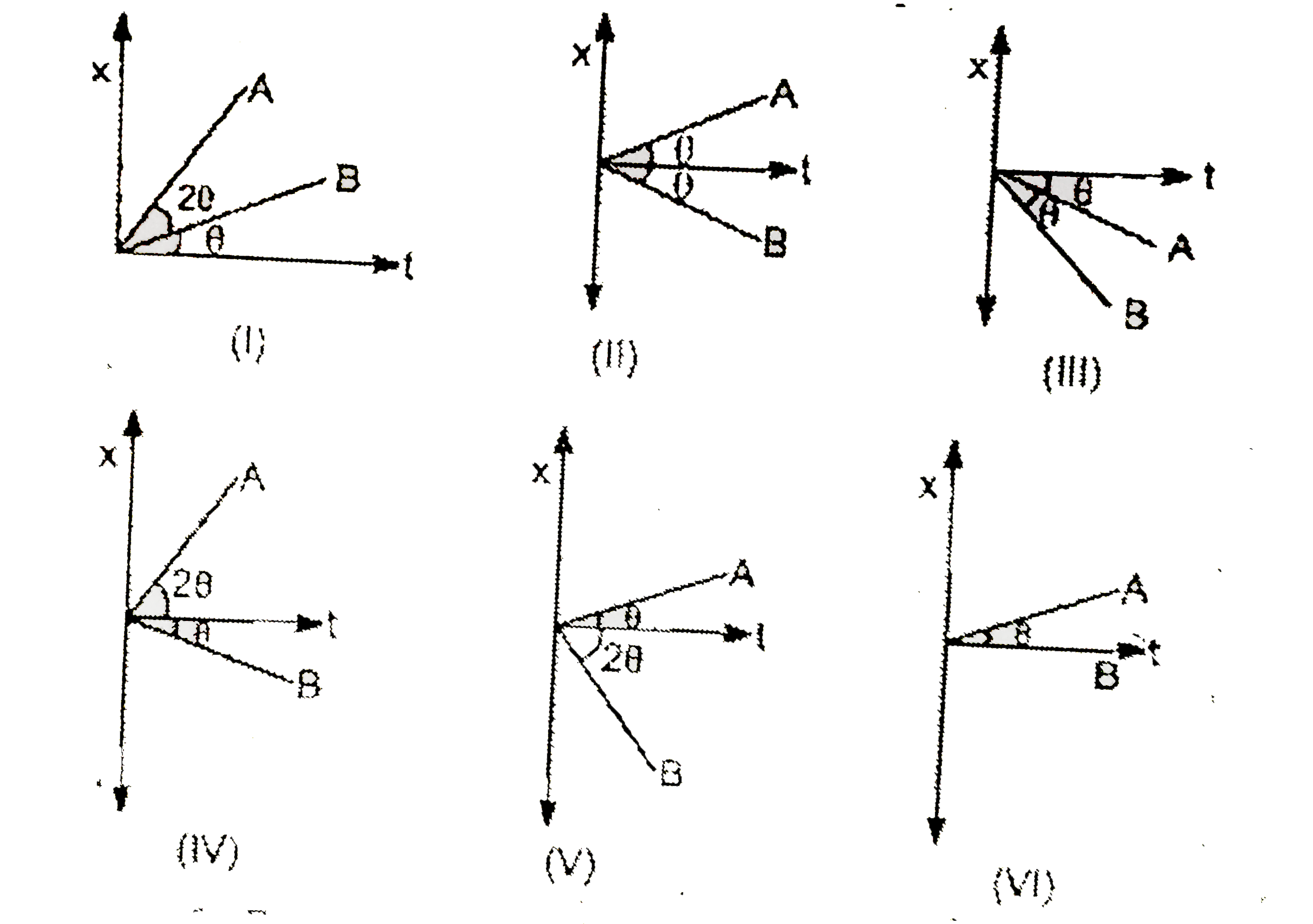
Which graphs pertain to physically possible explosios?View SolutionQuestion 174
An initially stationary box on a frictionless floor explodes into two pieces, piece A with mass mA and piece B with mass mB. Two pieces then move across the floor along x-axis. Graph of position versus time for the two pieces are given
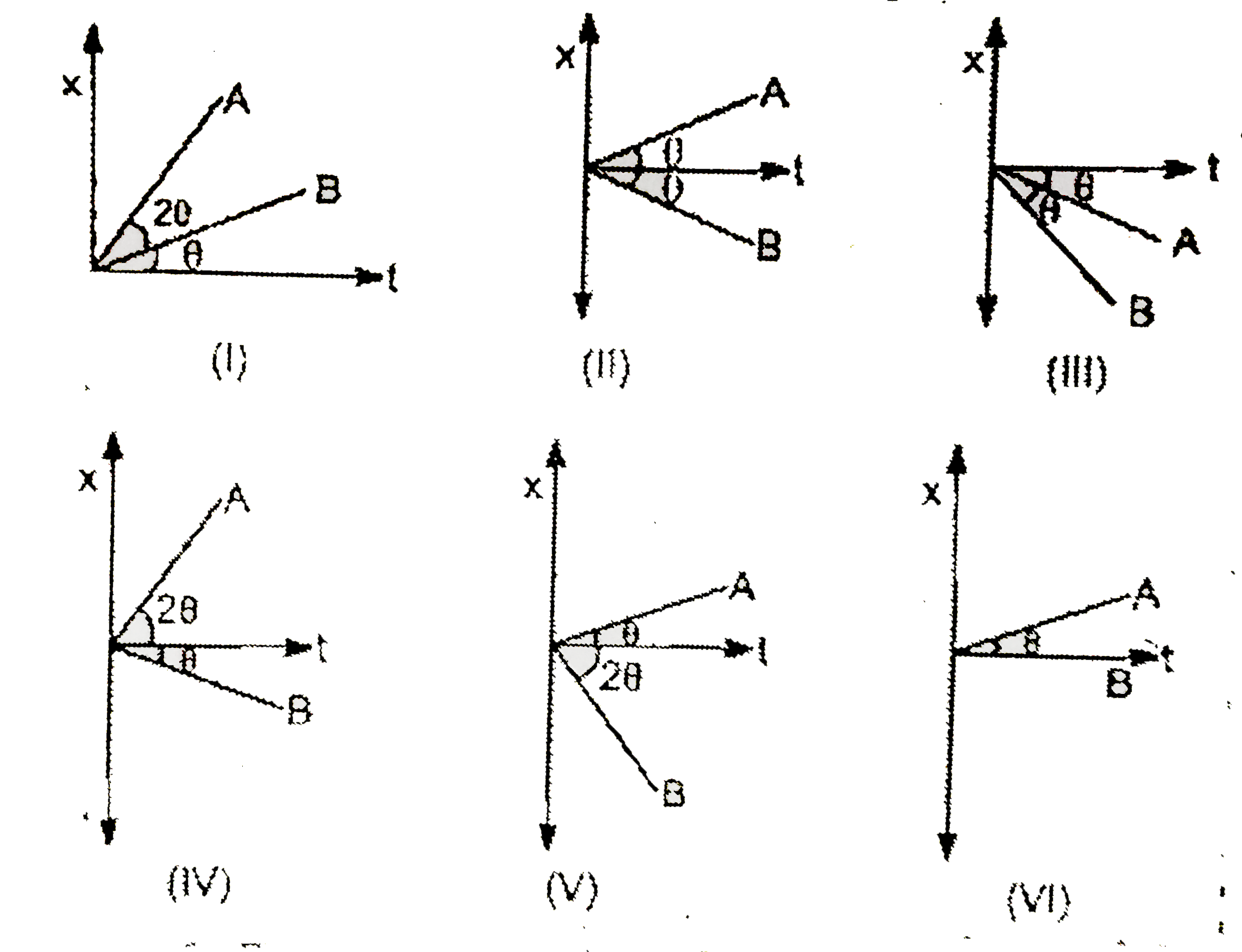
Based on the above question. Match column A with the column B.
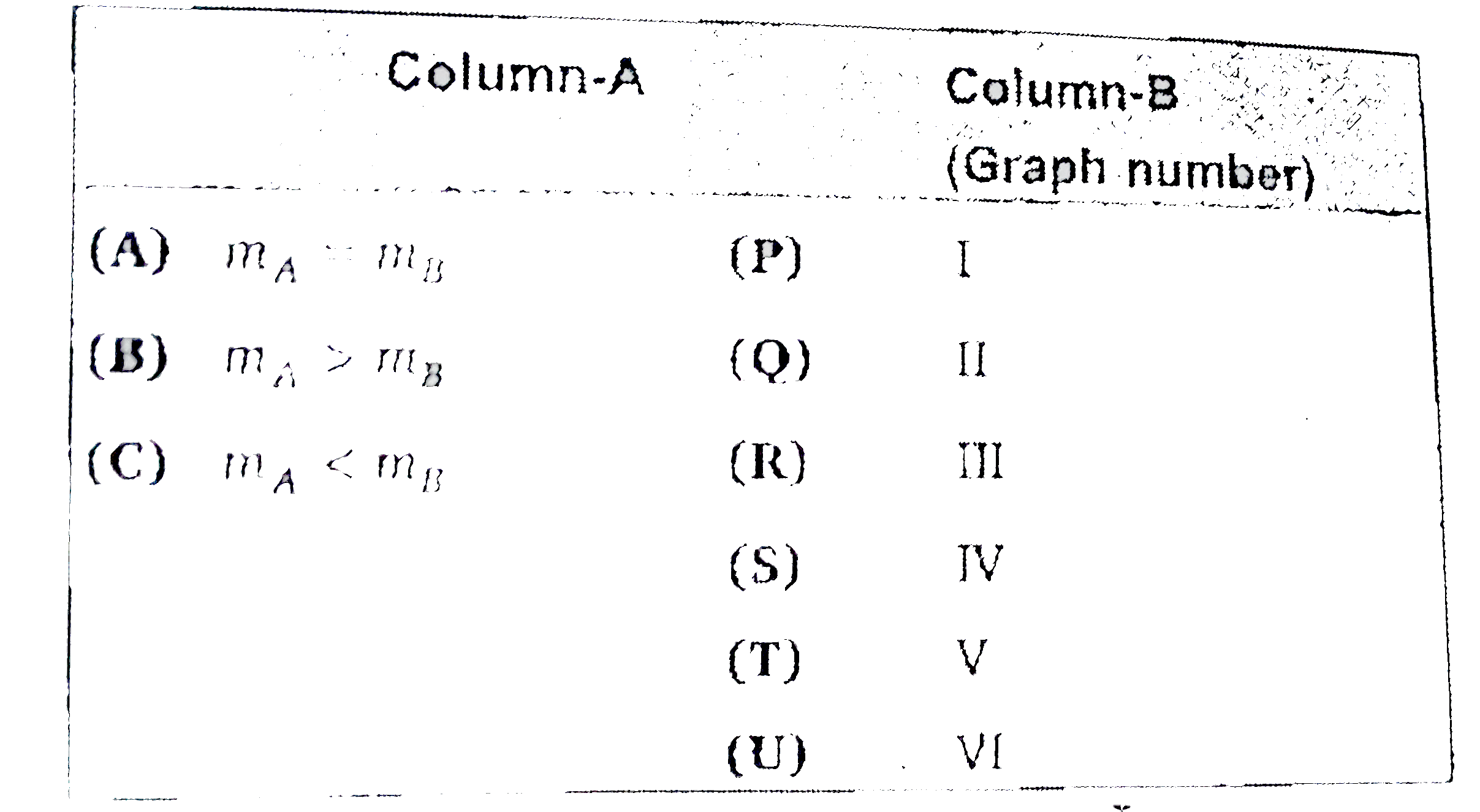 View Solution
View SolutionQuestion 175
An initially stationary box on a frictionless floor explodes into two pieces, piece A with mass mA and piece B with mass mB. Two pieces then move across the floor along x-axis. Graph of position versus time for the two pieces are given
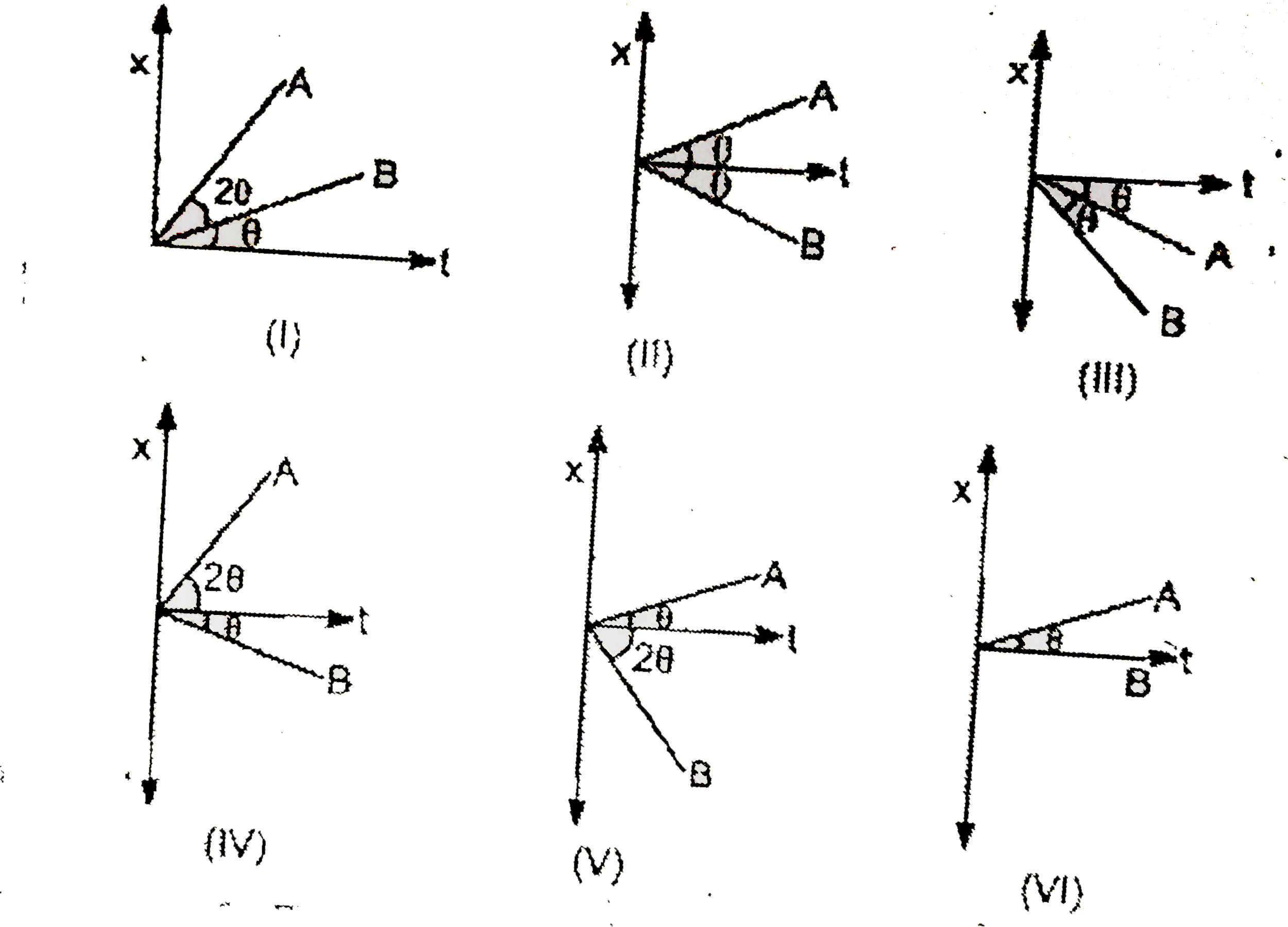
If following graphs are possible then, in which of the following cases external impulse must be acting on the box?View SolutionQuestion 177
A particle of mass m, kinetic energy K and momentum p collides head on elastically with another particle of mass 2m at rest. After collision, :
Column IColumn II(A)Momentum of first particle(p)3/4p(B)Momentum of second particle(q)−K/9(C)Kinetic energy of first particle(r)−p/3(D)Kinetic energy of second particle(s)8K9(t)NoneView Solution

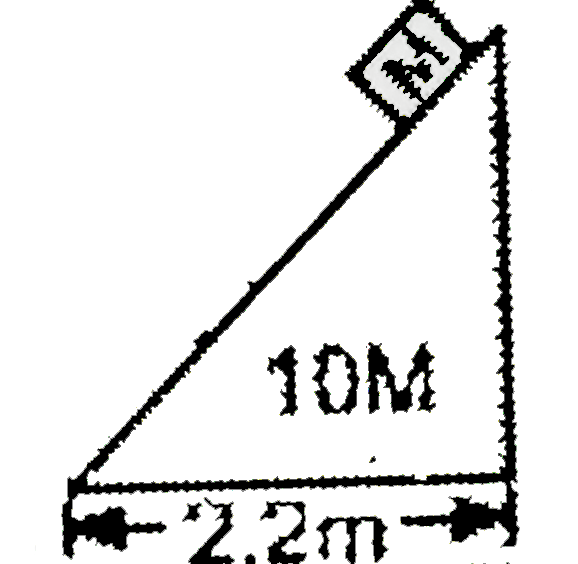
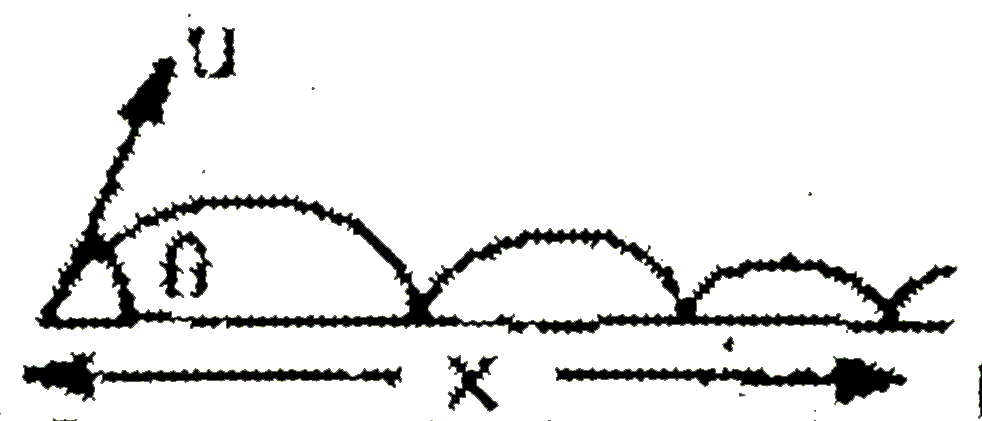
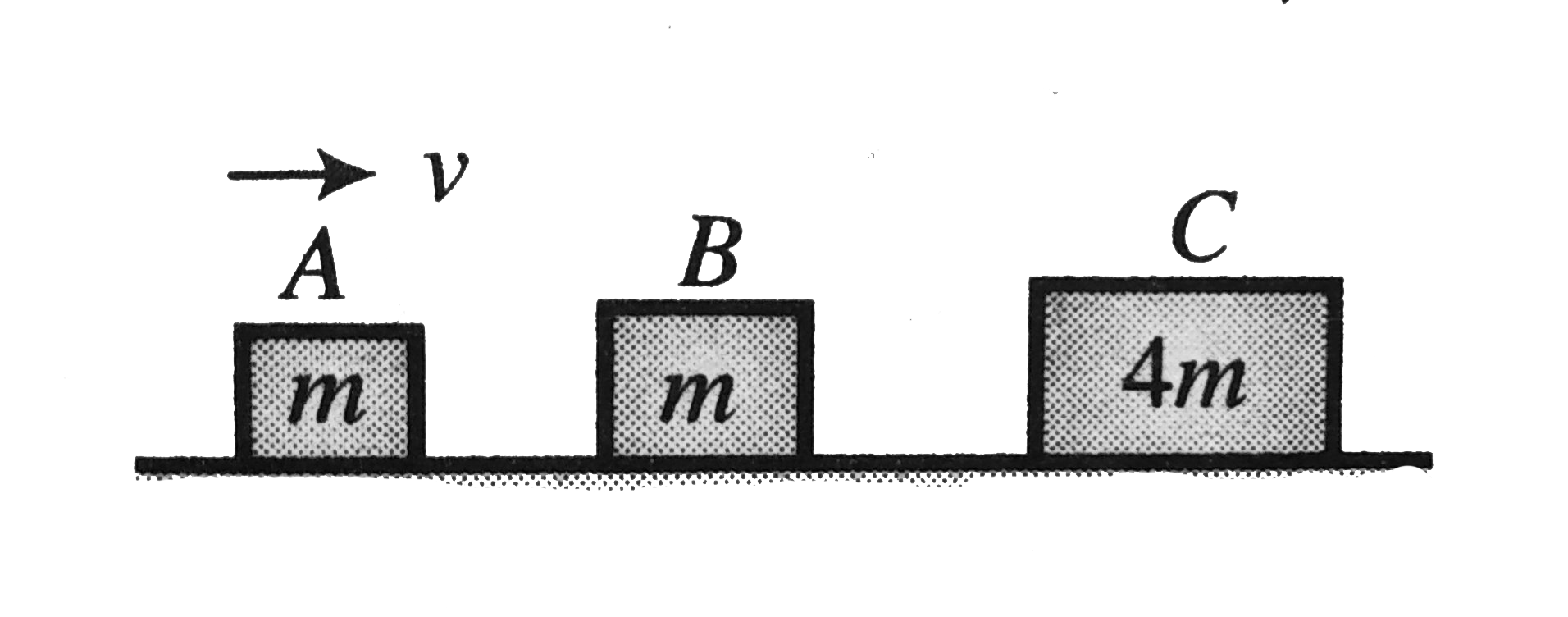
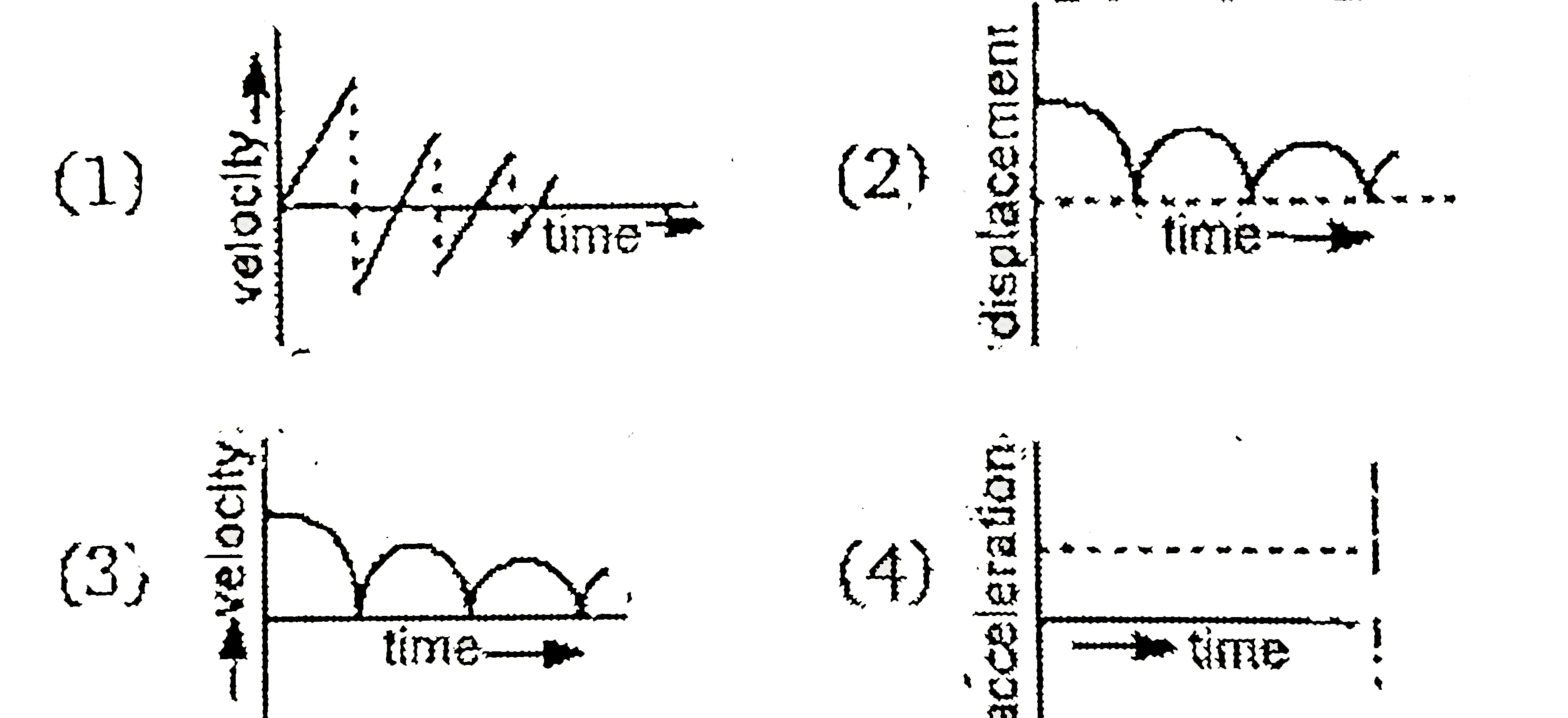
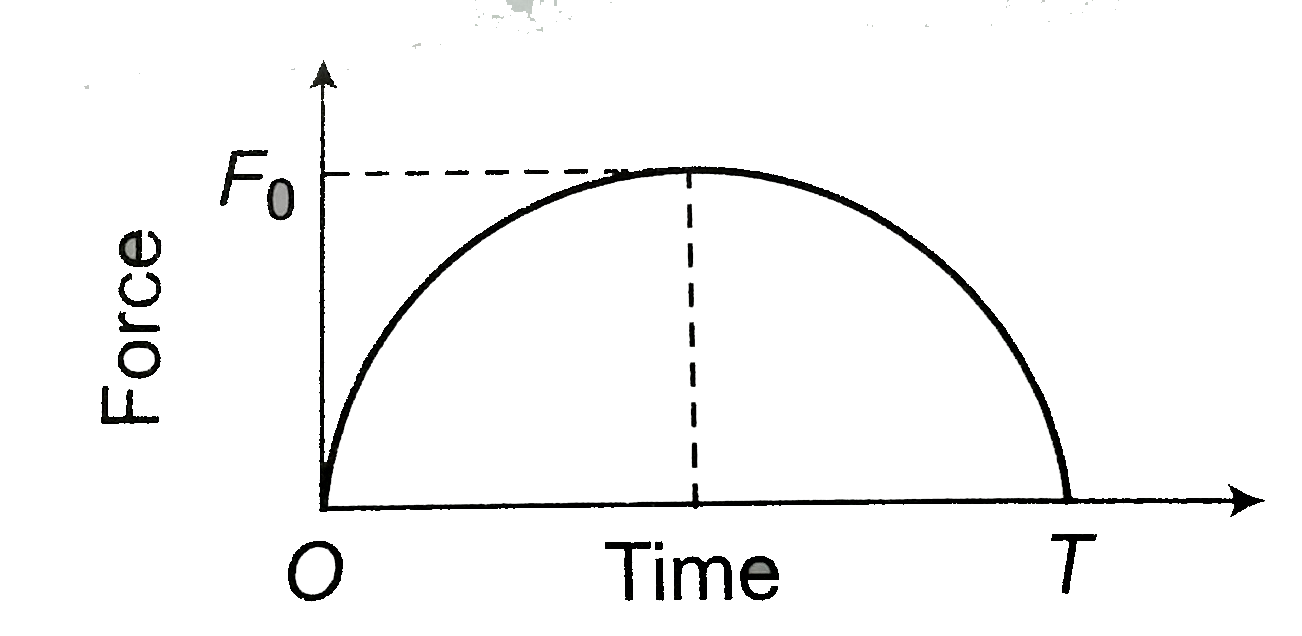
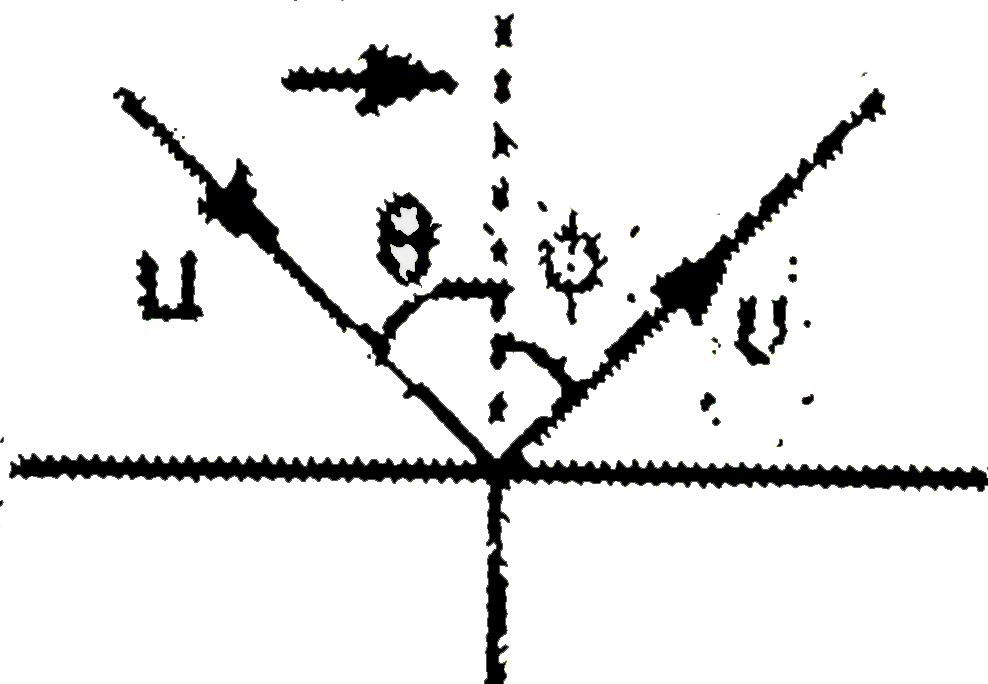


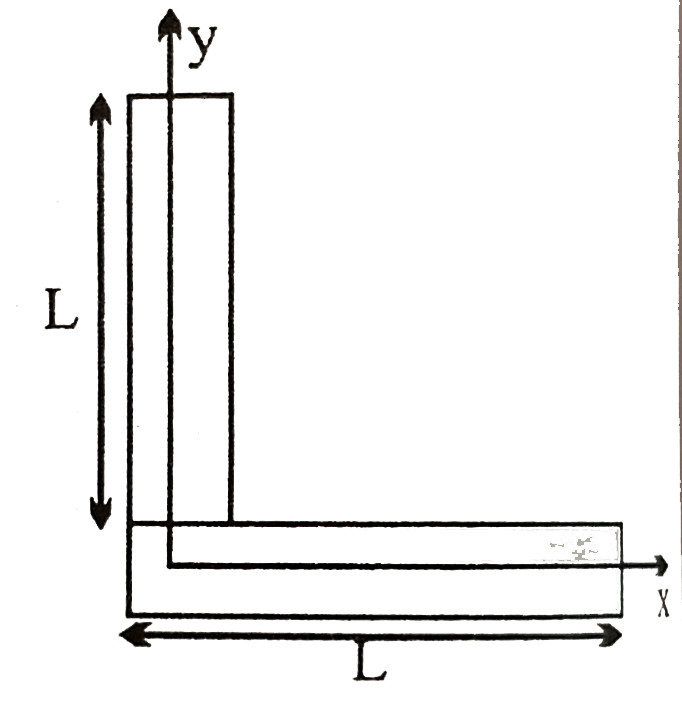

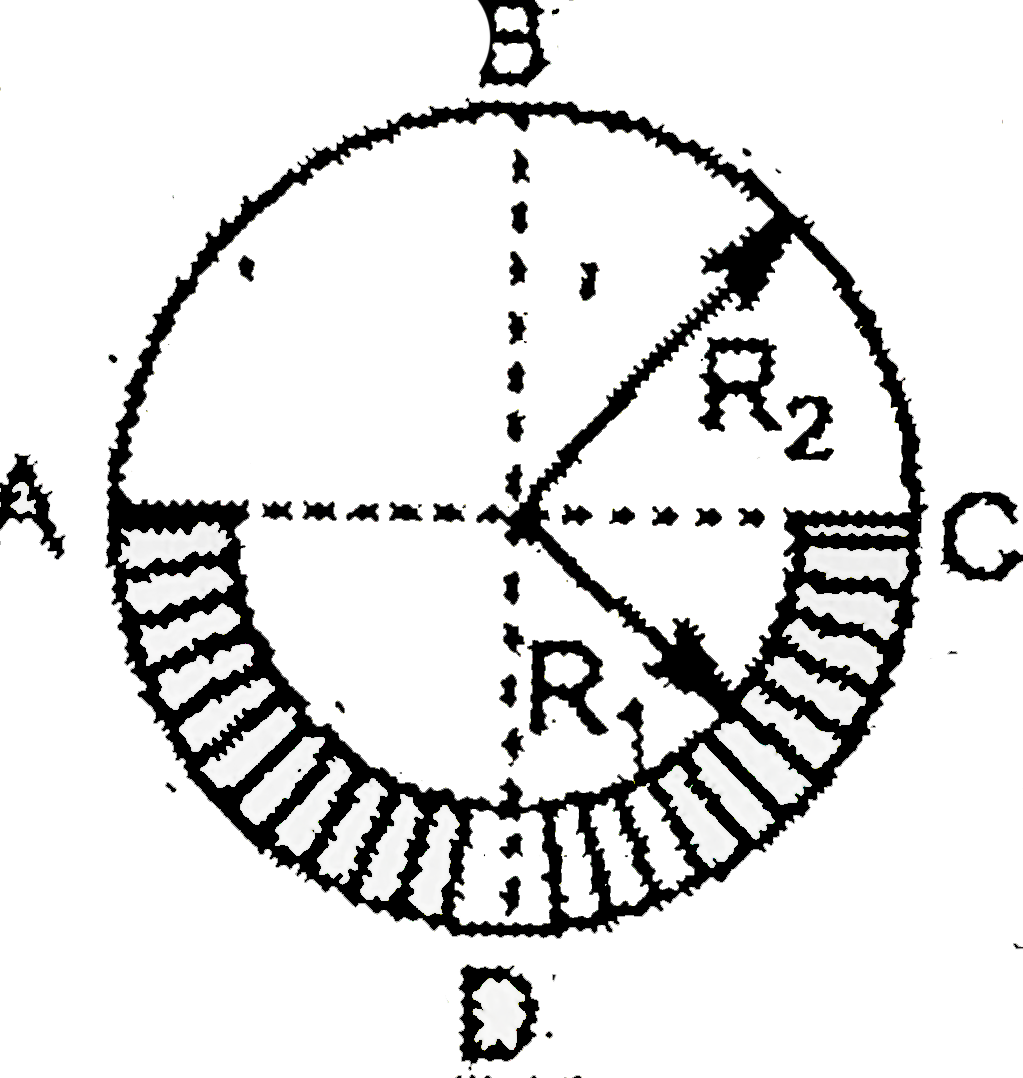
 .
.

